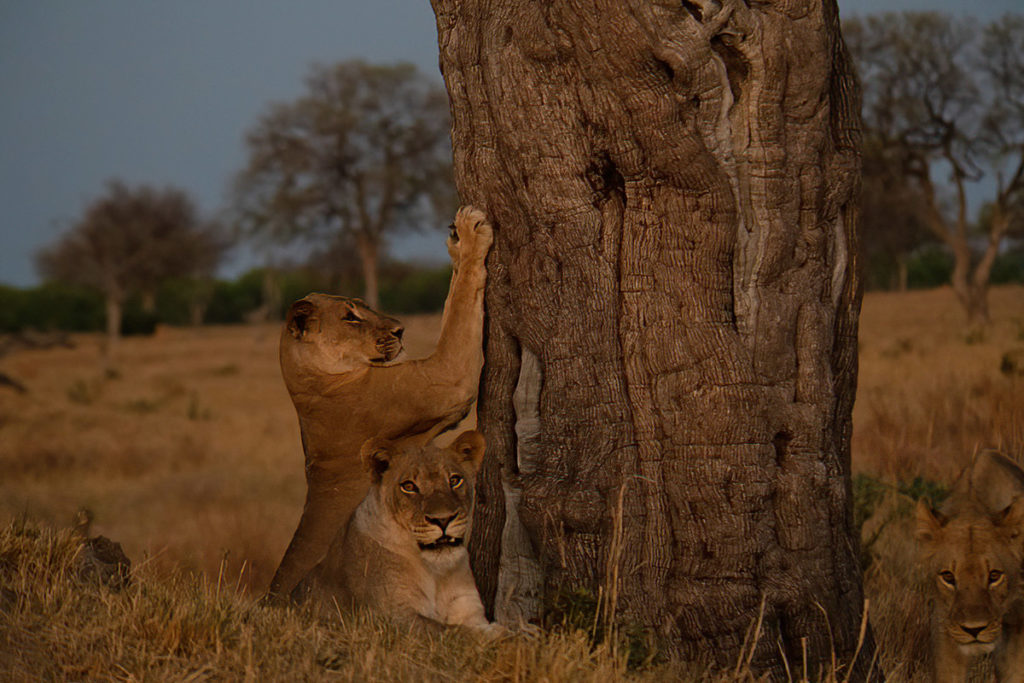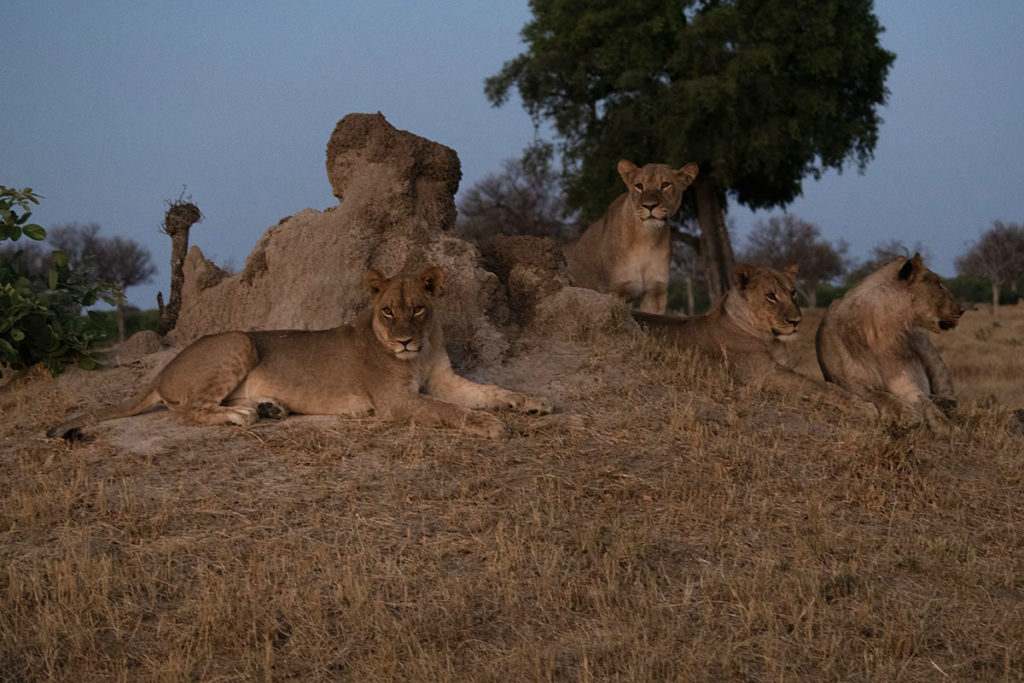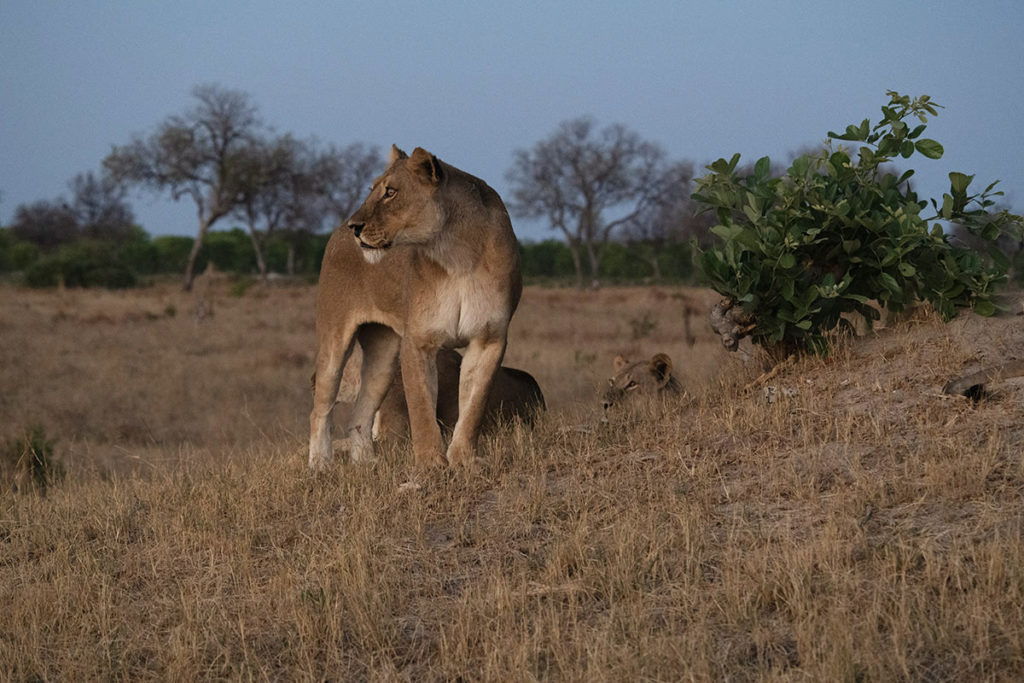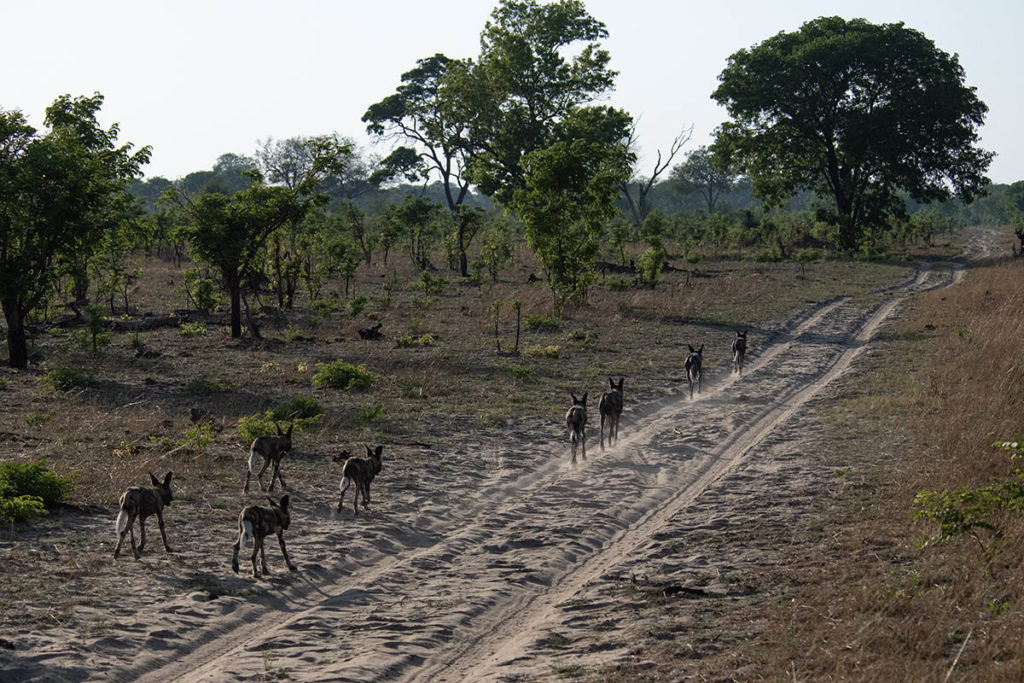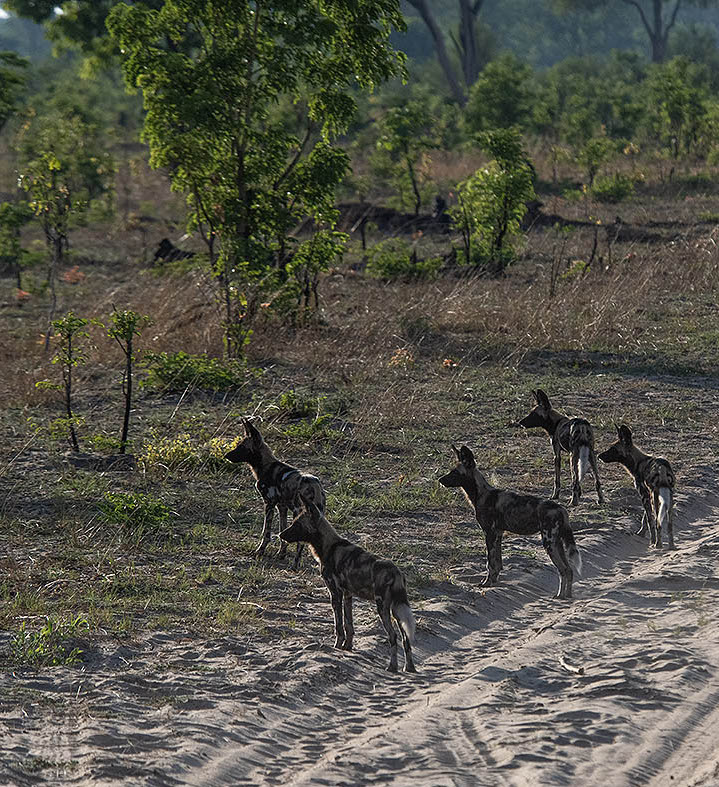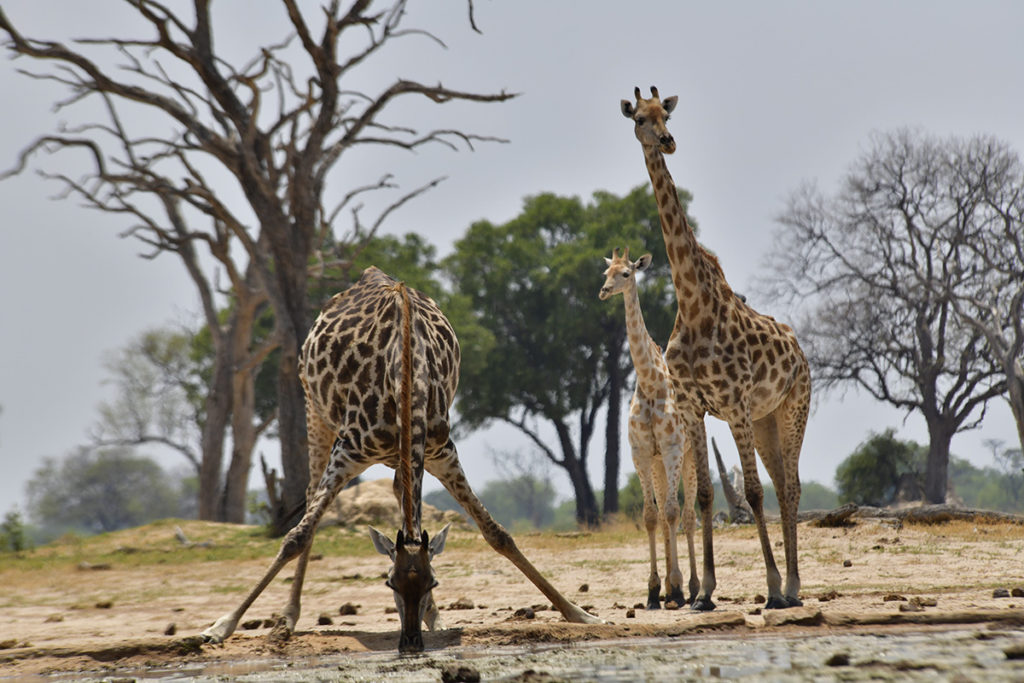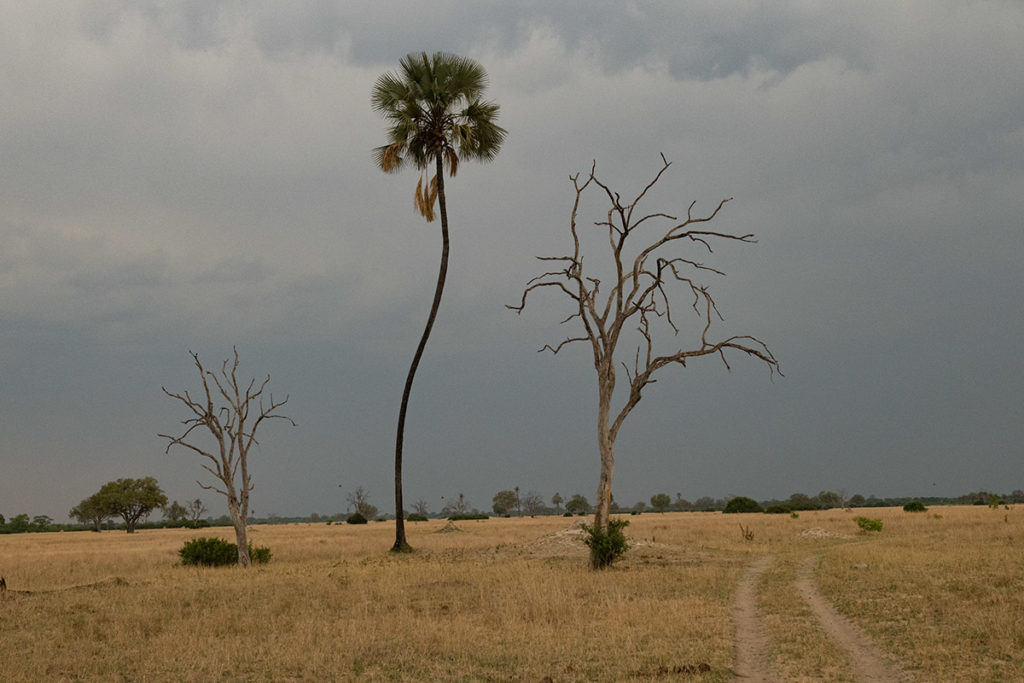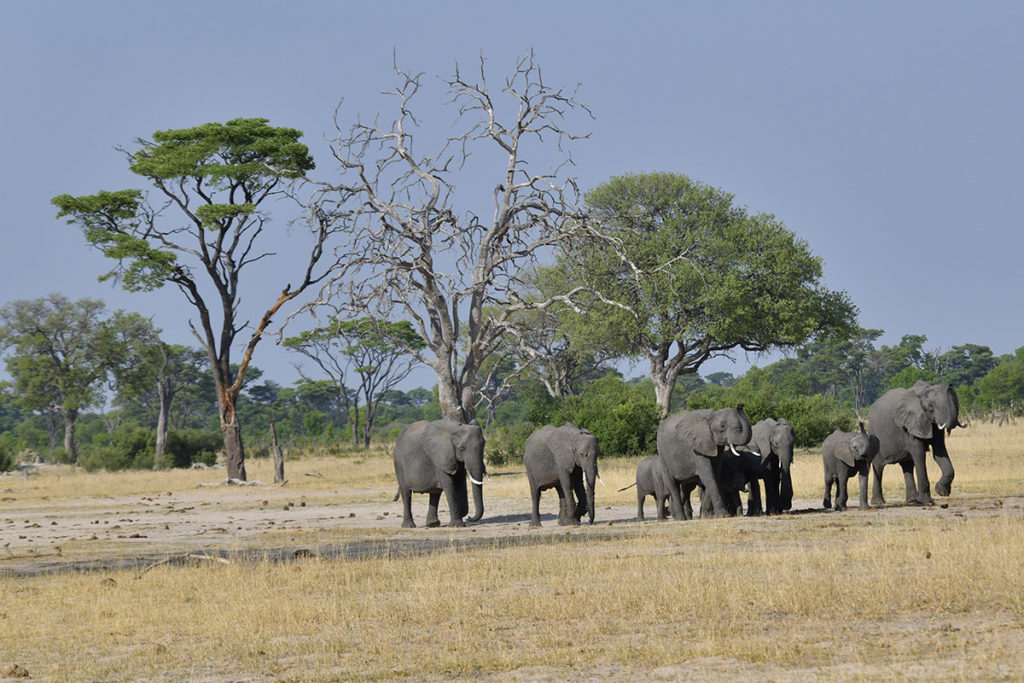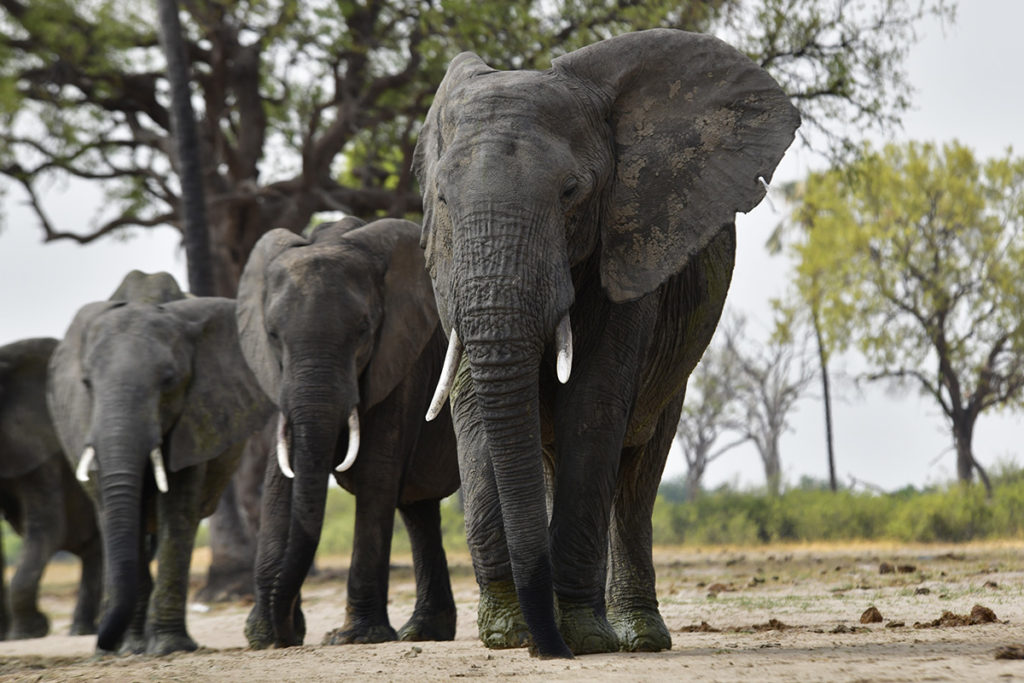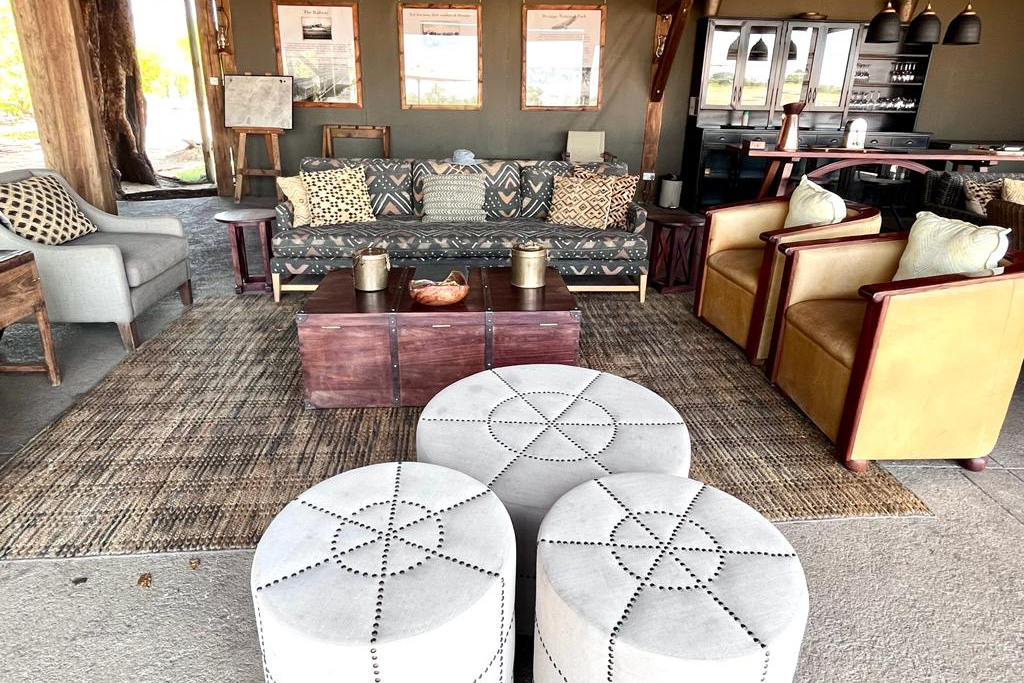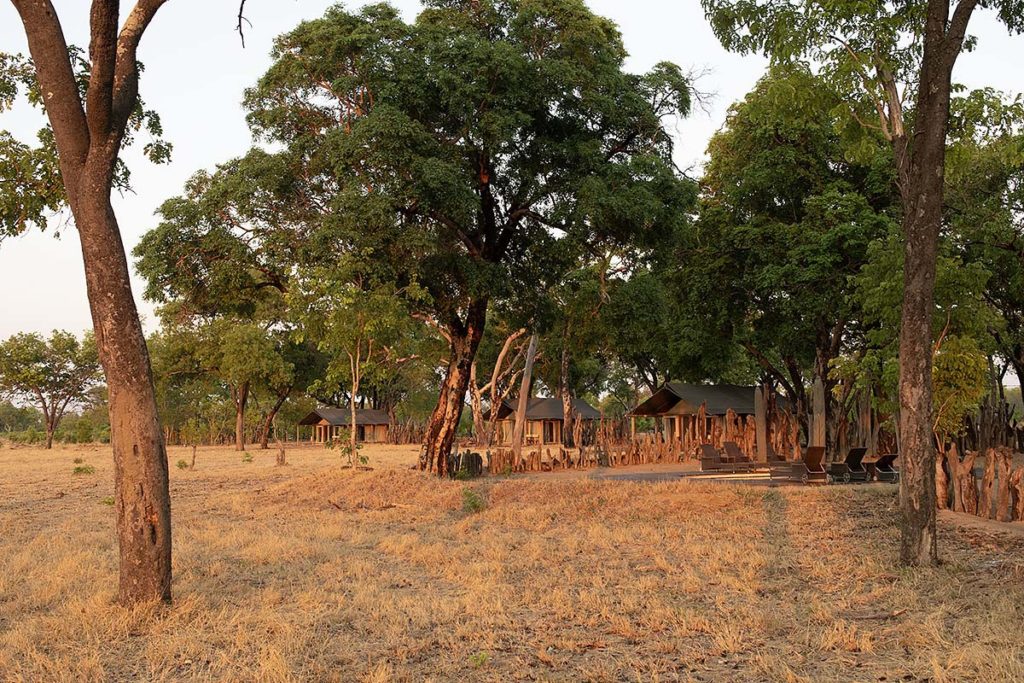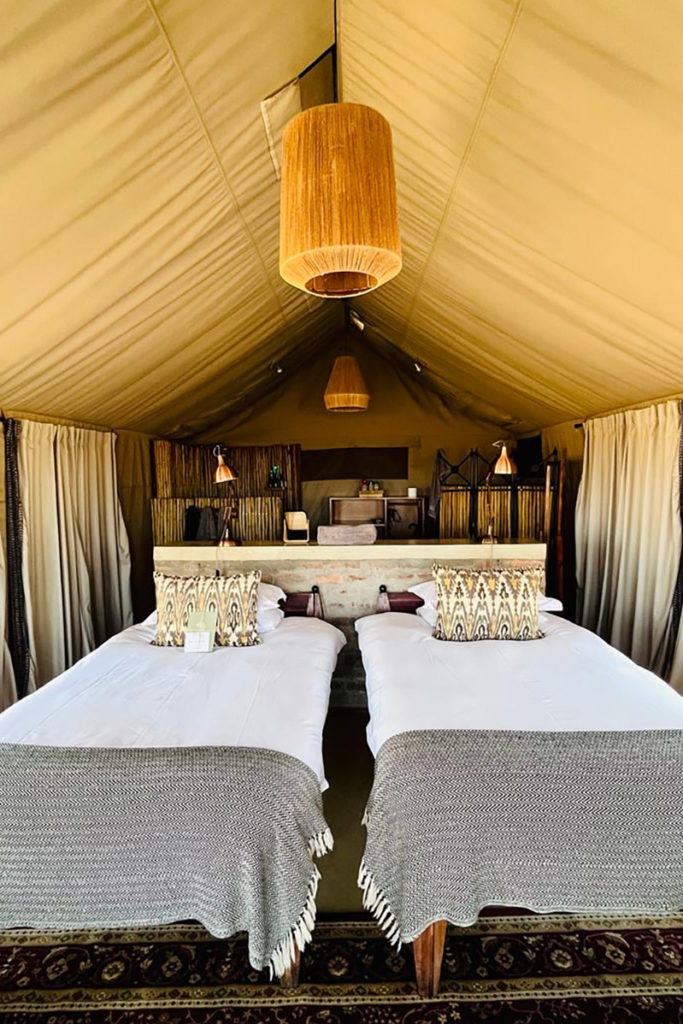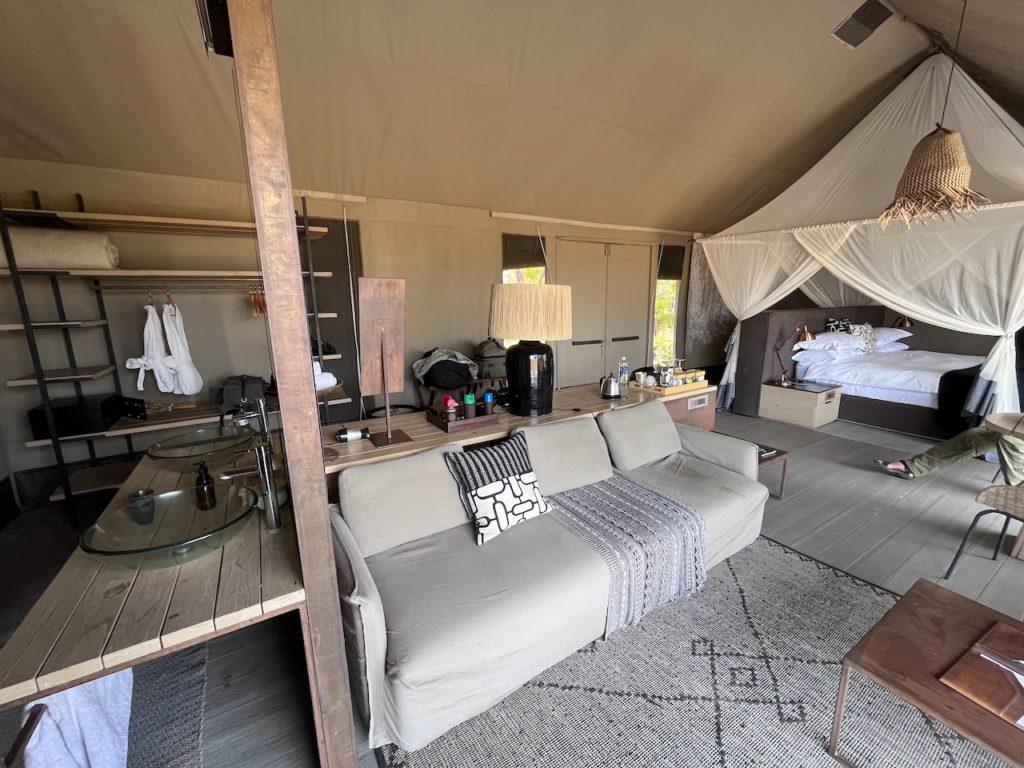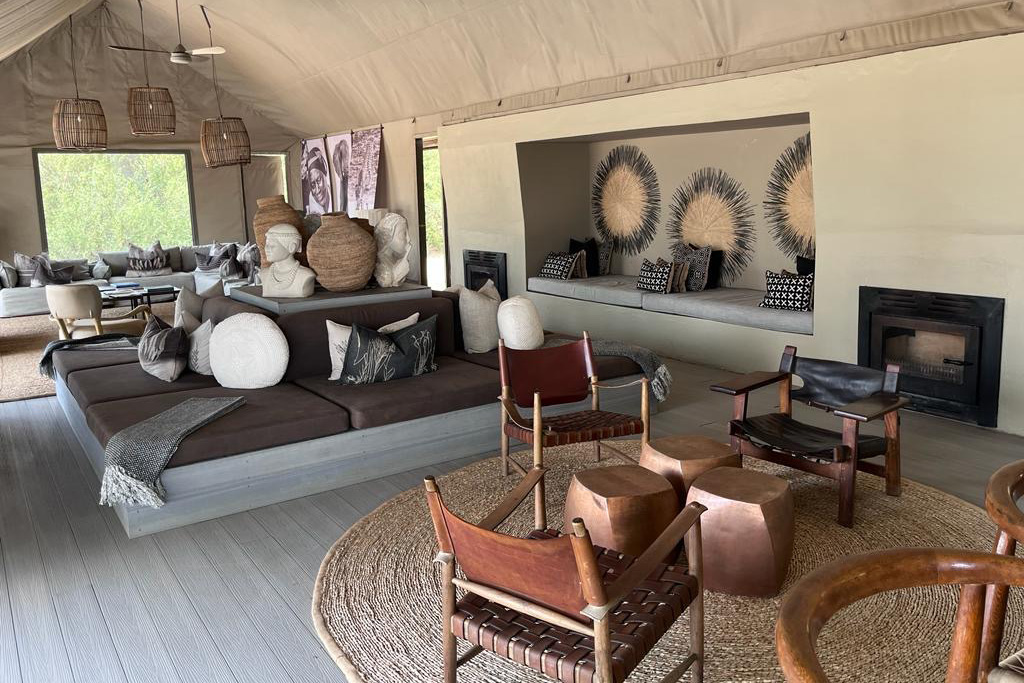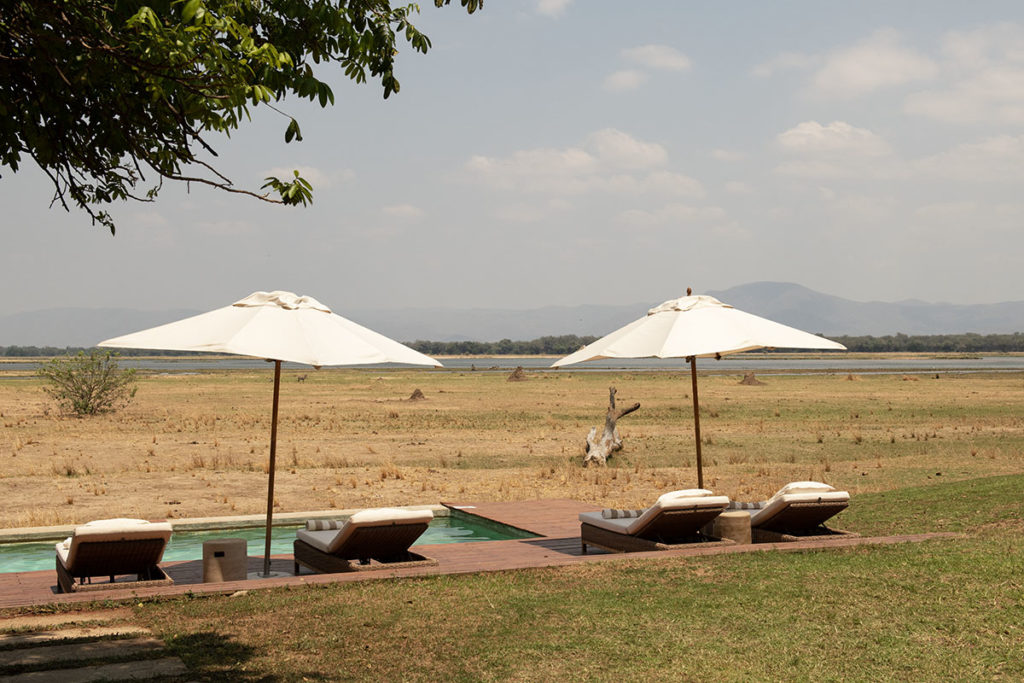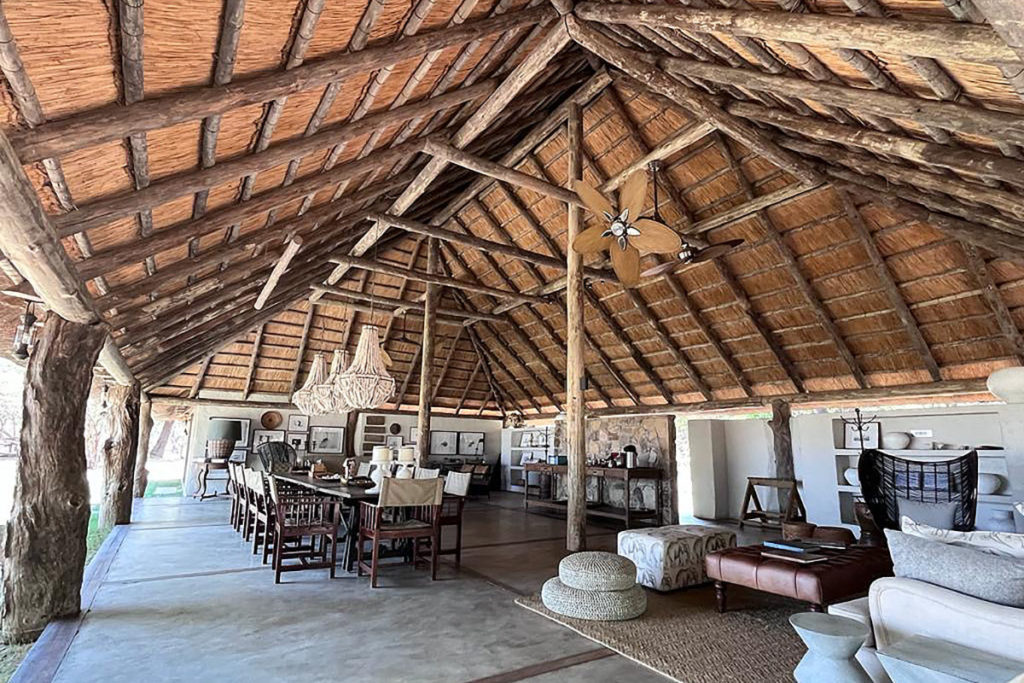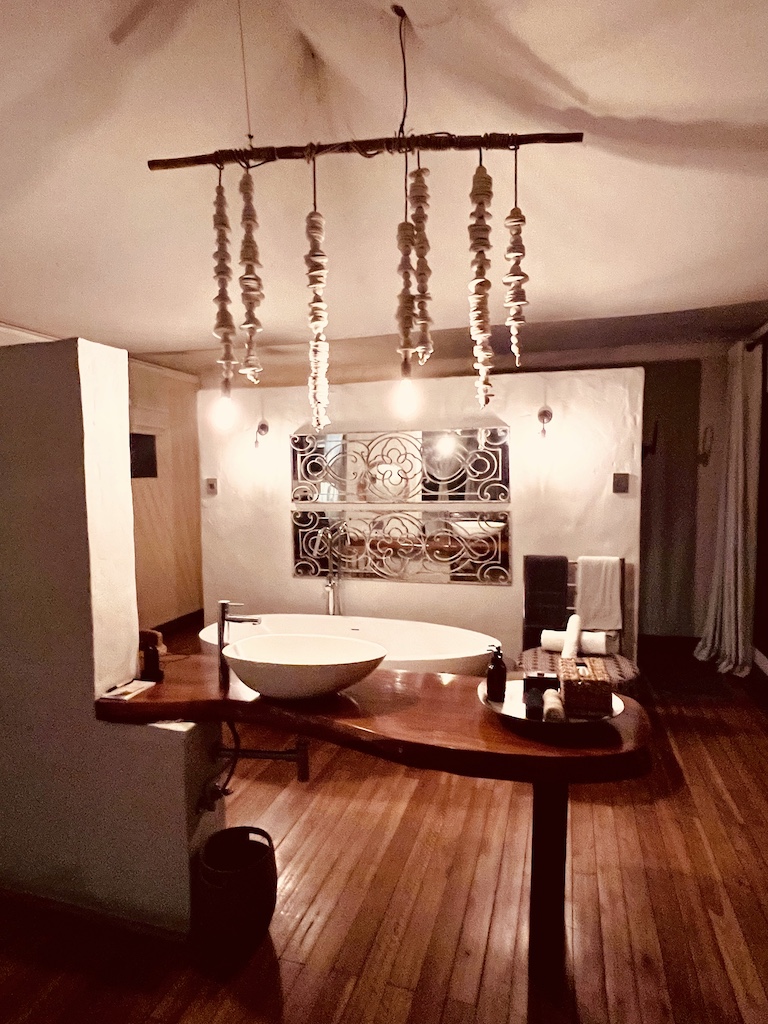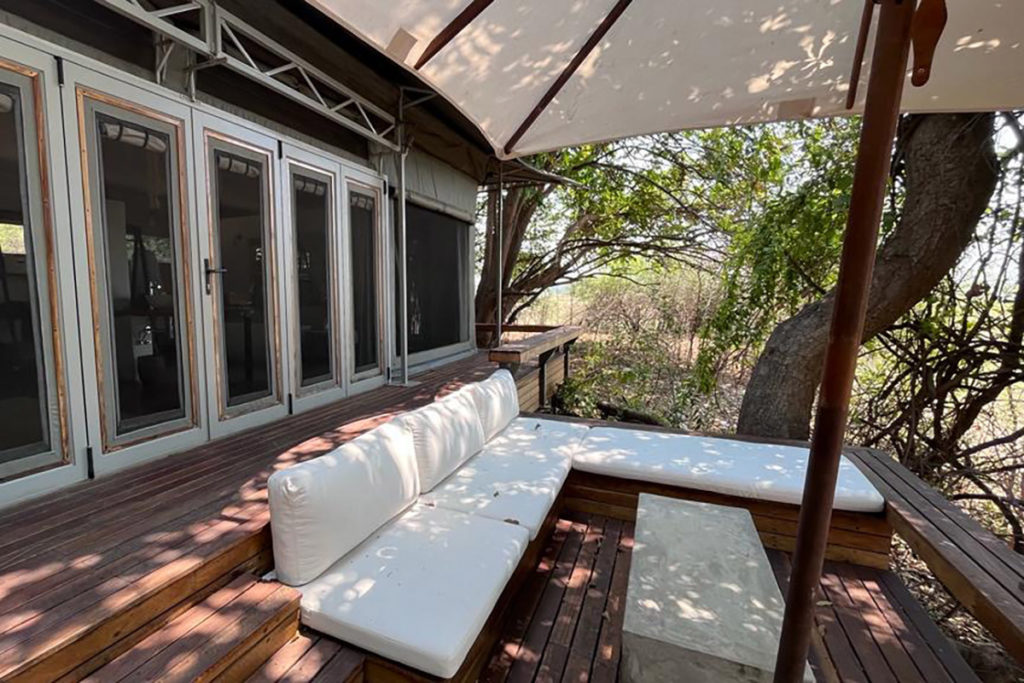Painted dogs, also known as the African wild dog or painted wolf, are one of the most endangered predators on earth. Pristine Zimbabwe is one of the few places to see painted dogs with luck and where Wilderness along with their own anti-poaching unit and the Painted Dog Conservation have been fighting for their survival for years.
Text: Angelique van Os | Photography: Henk Bothof
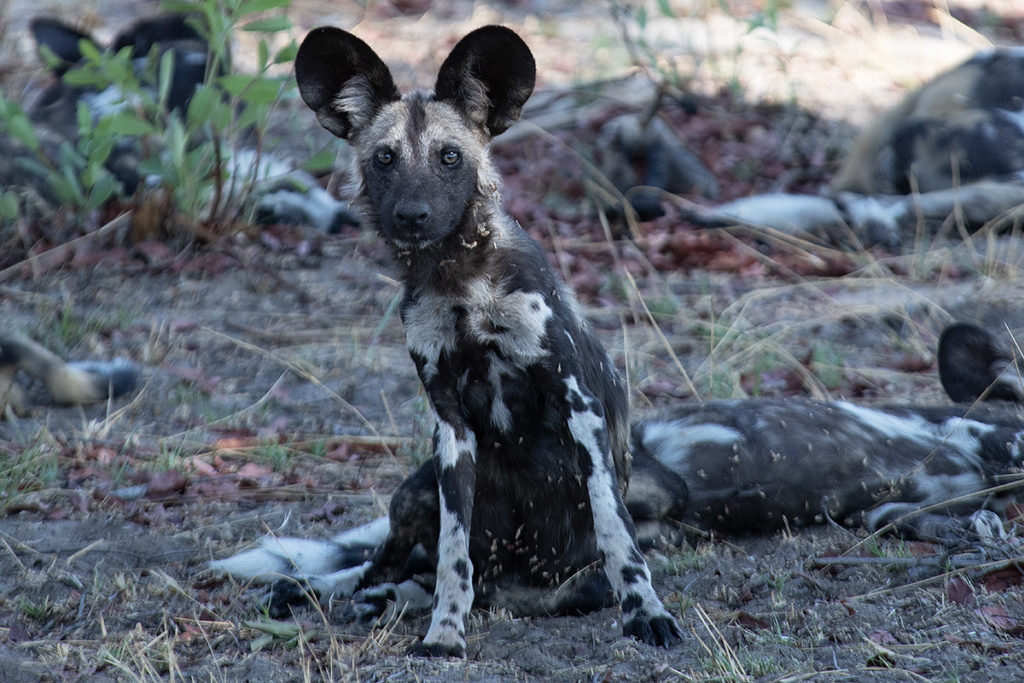
“You just missed the painted dogs,” we hear upon arrival at Wilderness Davison’s Camp. That’s bad news, because it was precisely for these special animals that we traveled to Hwange, Zimbabwe’s largest national park. The country has a total of 11 national parcs. The chances of seeing the social animals with slender builds, beautifully shaded fur and recognizable large ears are slim, but possible. They can easily travel 40 kilometers per day with a full stomach, so their habitat is large.
A century ago there were 500,000 specimens living scattered across the African continent. Now there are only about 7,000 painted dogs left, which live mainly but fragmented in Southern and East Africa. An estimated 700 painted dogs live in Zimbabwe, of which four packs (20 to 30 animals) in Mana Pools and six in Hwange (approximately 160 dogs). Zimbabwe is one of the few places on Earth with a healthy population of painted dogs.
Special spectacle
Perhaps the pack will still be around the next day. And we have yet to recover from a special spectacle. Because while the African wild dogs were hunting close to the lodge, around dusk we witnessed no less than a pride of 22 lions! They were everywhere and incredibly close. Strolling in front of the car, right in front of it, behind it, playing in the sand and from a termite mound they kept a close eye on us.
Eye to eye
One of the lionesses was so curious that she snuck toward the car and looked me straight in the eye. What would she think? According to our guide Elias Cigha, not much, because (predatory) animals do not distinguish a person from a vehicle. They see that as one. That is why you are safe in a car during a safari, as long as you don’t make any unexpected movements or loud noises.
400 lions in Hwange
Guide Elias has been working for Wilderness since 2011, one of the leading companies in sustainable tourism and nature conservation within the high segment of Southern Africa (see box). He knows every spot of the Hwange National Park concession, which has existed since 1928. As many as 400 lions live in the park, in an area of 14,605 km 2 , the same size as Belgium. “Hwange is one of the best places in Africa to see lions. It is rare that guests do not see lions here. The Wilderness concession covers 523 km 2 and provides a habitat for approximately 80 lions, which is a high number,” the guide said.
Nationaal Park Hwange has existed since 1928 and has rugged, wooded vegetation alternating with various open plains. Artificial waterholes have been used by the park since 1935, because the area, which is the same size as Belgium, has no natural rivers or lakes. Elephants play an important role in this. Wilderness has offered water dens in their concession since 1996.
Natural enemies
The downside is that the high population of lions is a threat to the painted dogs – as well as to cheetahs – because they see the wild dogs as competition. They do not hesitate to kill puppies. The same goes for the spotted hyenas. Because both lions and hyenas are physically stronger and outnumber painted dogs, they sometimes lose their prey to these natural enemies. The African wild dog is very successful in hunting because the intelligent animals work well together, they are fast and have good endurance.
Needle in a haystack
The next morning we leave before dawn. Elias quickly picks up the tracks of the painted dogs, although it is like finding a needle in a haystack with so many tracks of other animals. And only one pack lives in the concession, consisting of eighteen dogs. The low vegetation doesn’t help either, which is growing rapidly thanks to the upcoming rainy season. The bushes provide the perfect shelter for animals.
White pointed tail
We drive past waterhole back pans. There are herds of elephants, baboons, a group of giraffes and antelopes, but no painted dogs. After about fifteen minutes of driving we pass a T-junction and out of the corner of my eye I suddenly see movement in the bushes. “Wild dog!” I shout excitedly. Thanks to the white pointed tail I know for sure. And soon I see more dogs appearing. We are beaming from ear to ear; as if we have discovered a valuable treasure. After a few minutes the pack moves at a brisk pace across the sandy road and the group emerges.
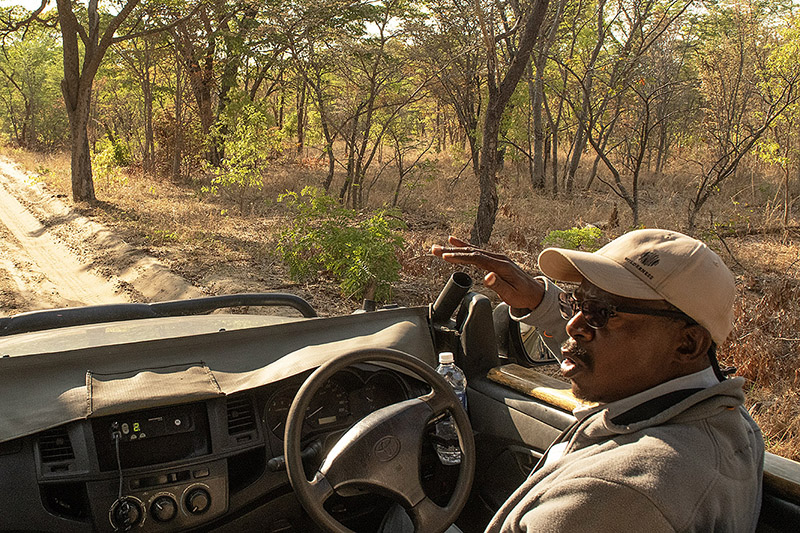
FACTS painted dogs
| Latin name: | Lycaon pictus |
| Various names because: | men formerly mistook the animal for a wild dog or wolf-like. |
| Related to: | Canidae family, but not a direct family of wolves, coyotes , dogs and jackals. The African wild dog is the only extant (living) species in the genus Lycaeon. |
| Weight: | 22-32 kg |
| Shoulder height: | ± 68 cm |
| Pack size: | 4-20 animals (variable ) |
| Lifespan: | ± 10 years |
| Active: | mainly in the morning and during the day |
| Litter size: | 7-10 of the alpha female. In the case of a possible second female, which occasionally occurs, then once as much. Gestation period is 2.5 months. |
| Care: | the entire group takes care of the puppies and protects them. |
| Independence: | puppies are born in dens where they stay for about 12 weeks. Then they follow the group. From the age of 2 they look for their own pack. |
| Group leader: | alpha female |
| Food : | carnivore, mainly antelopes. Mana Pools is the only place in Africa where dogs hunt baboons. |
| Habitat: | open plains and open areas of forests. |
| Water: | They mainly get moisture through food. |
| Maximum speed: | 65 km per hour. |
| Natural enemies: | lion, hyena, leopard. |
| Causes of death: | snaring/poaching, poisoning, disease such as rabies due to domestic dogs, collisions and shootings. |
As a precaution, many dogs, lions and leopards are shot or poisoned by farmers. While painted dogs don’t attack people.
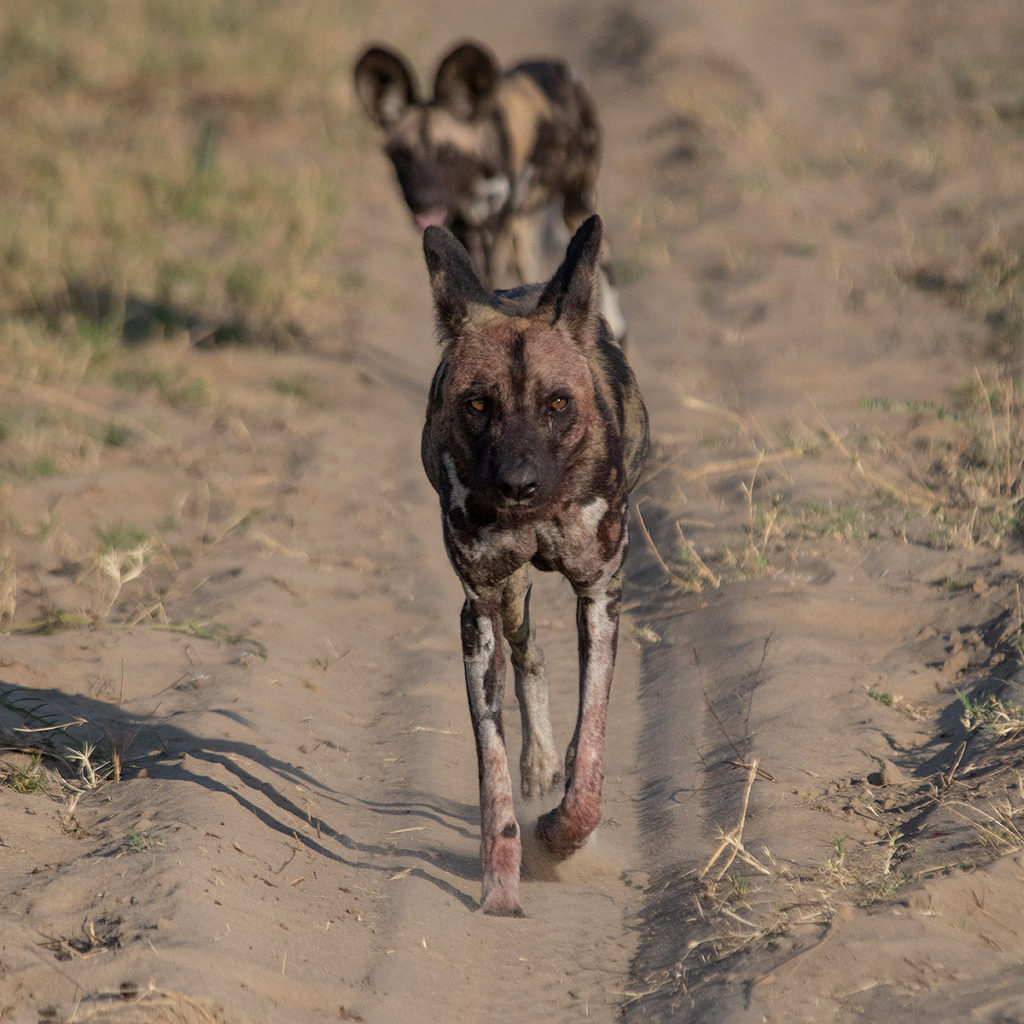
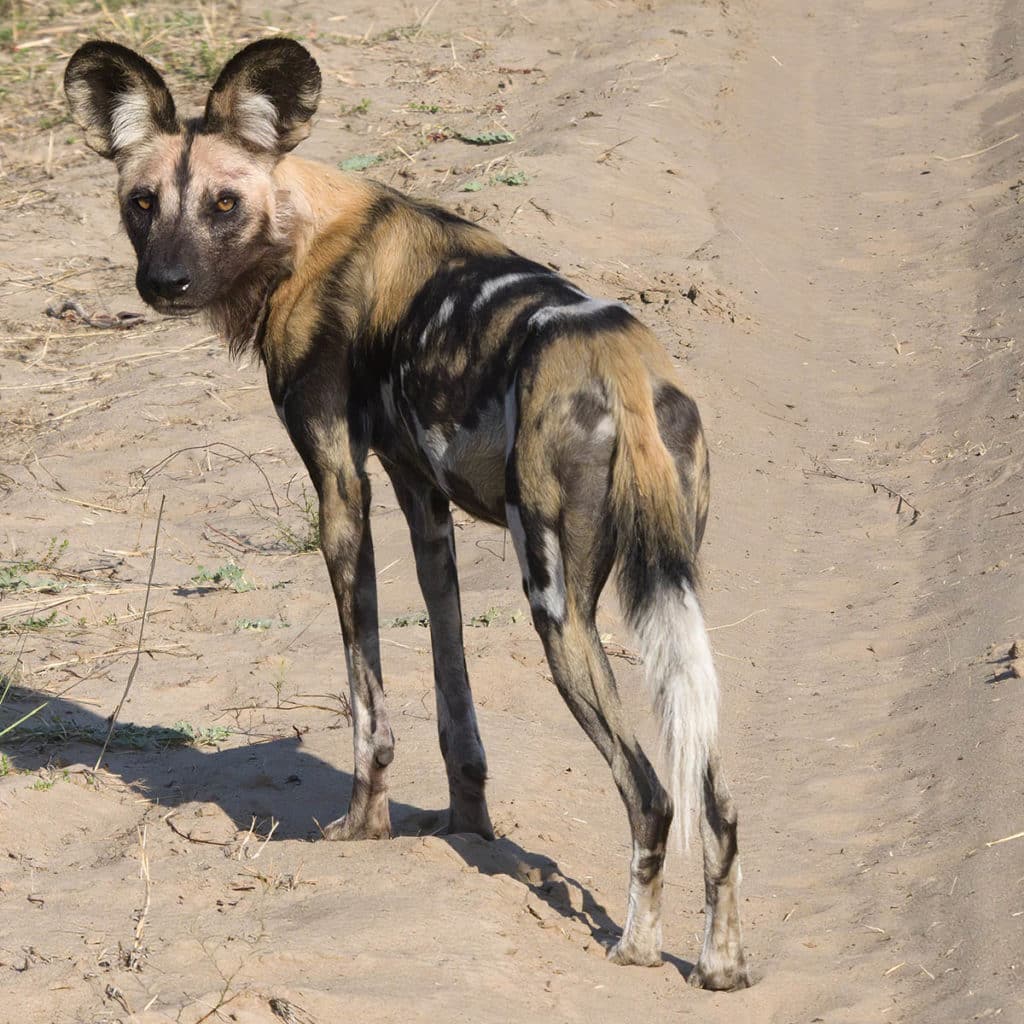
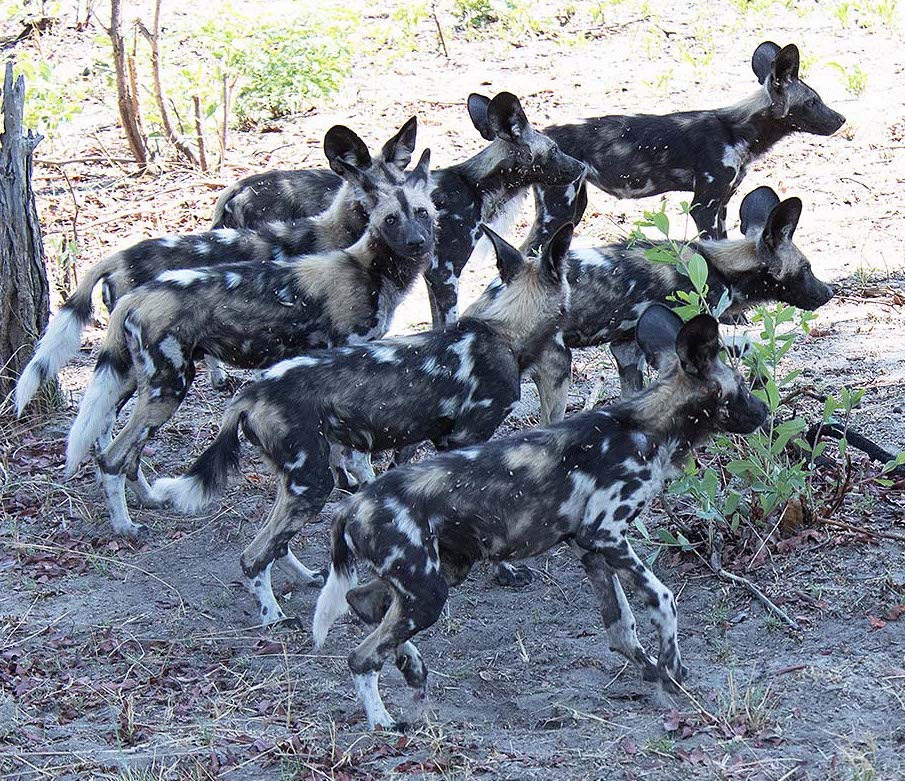
Turn right
“I don’t see all the puppies,” Elias says worriedly. When we stop for a moment we hear a high-pitched noise. “They call the others. Painted dogs are super social animals and do not abandon each other,” says Elias. This soon turns out to be correct, because the dogs turn around and walk back towards the call. We drive carefully behind it. After a few minutes, more dogs appear from the bushes. They greet each other enthusiastically and the puppies, which are four months old, play happily. Now that the pack is complete, the alpha female decides to plop down in the middle of the dirt path under the rich shade of a large tree. The others follow his example. Just recover from their journey and relax, because judging by the blood residue on their jaws and legs, they have eaten well.
Alert painted dogs
Yet one of the ten puppies is missing. “Yesterday in the camp they already suspected that there was a fight between the wild dogs and hyenas over prey. That probably killed a puppy,” says Elias. Nature is harsh, and this is especially sad because the future of painted dogs is so seriously threatened. We realize how unique it is to observe the animals up close. The younger animals try to sleep, but the alpha male and female are restless and constantly alert. At the slightest sound they shoot up, with the rest following suit. They lie down again just as quickly. Despite being predators, they must remain on the lookout for enemies. For the time being, the coast seems clear and we are enjoying the special moment.
Train track
Humans are – unsurprisingly – the biggest threat to the painted dogs. For example, dogs are regularly hit around the border areas of national parks (also in other countries), often causing fatal injuries. And in Hwange there is another threat; There is a railway line about a hundred meters from the dirt road where we spotted the pack. The route runs all the way from the famous Vicotria Falls straight through the park and has been in use since 1900. A freight train runs here twice a day. Before the pandemic, a passenger train also operated, but its operation is limited, partly due to the aftermath of the national economic malaise.
TIP: Since 2014, two tour operators have been offering the Elephant Express the opportunity to experience a safari from the track. This is done with a small train for 22 visitors.
Human wildlife conflicts
Due to advancing agriculture, habitat for wildlife is decreasing worldwide. This also applies to the African wild dog. Hwange and other parks, such as the northern Mana Pools, therefore suffer from various human wildlife conflicts. The buffer zones and surrounding villages are only a few kilometers from the concessions and park boundaries, where Zimbabwe often does not have protected fences. The animals can move freely, which ensures that young predators in particular make the crossing and attack livestock because they are easy prey. As a precaution, many dogs, lions and leopards are shot or poisoned by farmers. While painted dogs don’t attack people.
Scorpions Anti-Poaching Unit
Since 2011, Hwange has had its own Scorpion Anti-Poaching Unit (SAPU), which is supported financially and logistically byr Wilderness Wildlife Trust en Panthera. This anti-poaching unit consists of eight men, who rotate with a second group, stay and patrol in the park 24 hours a day. Their main goal is to preserve as much wildlife as possible and minimize poaching. They support and work together with scouts from the Zimbabwe Parks and Wildlife Management, of which there is always at least one armed ranger on the road. ↓
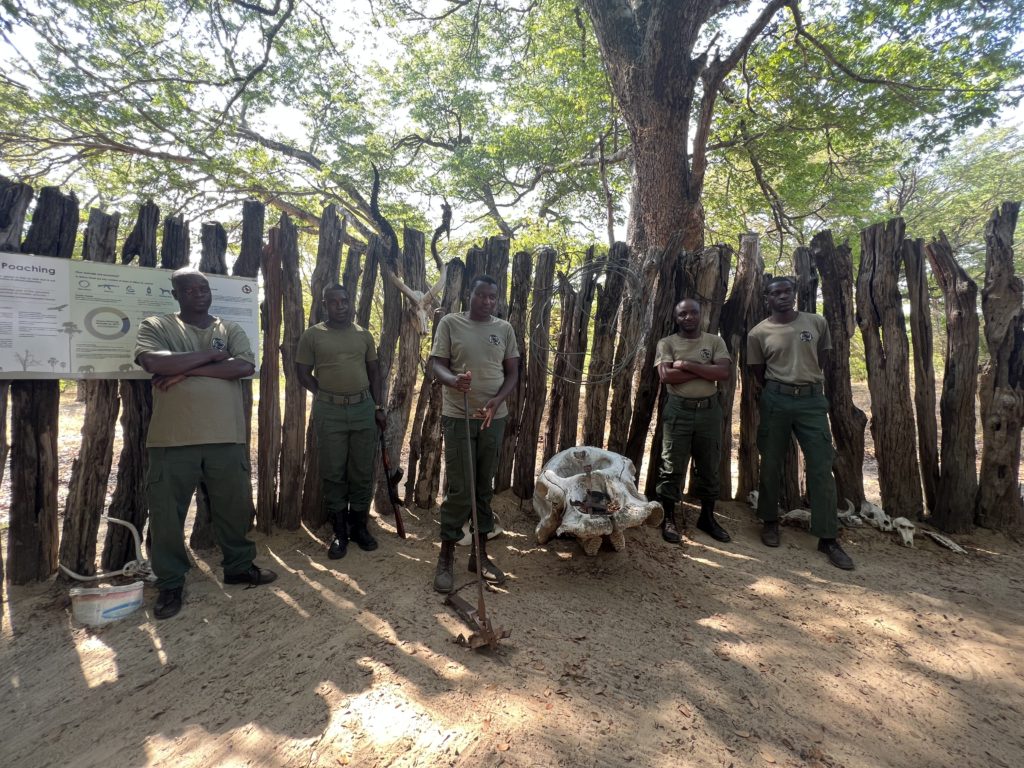
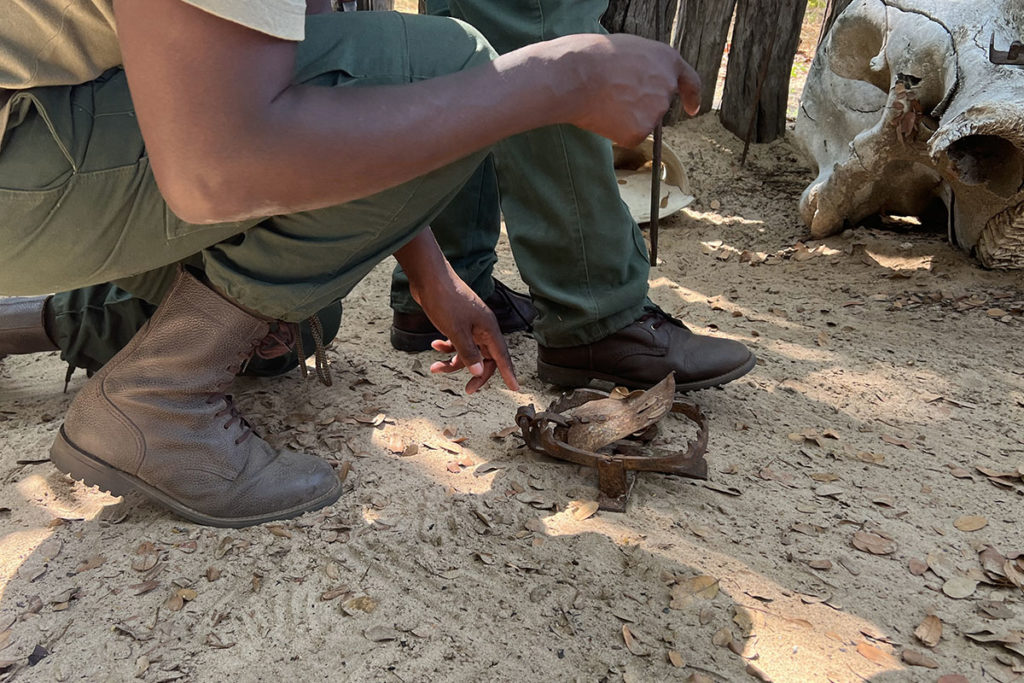
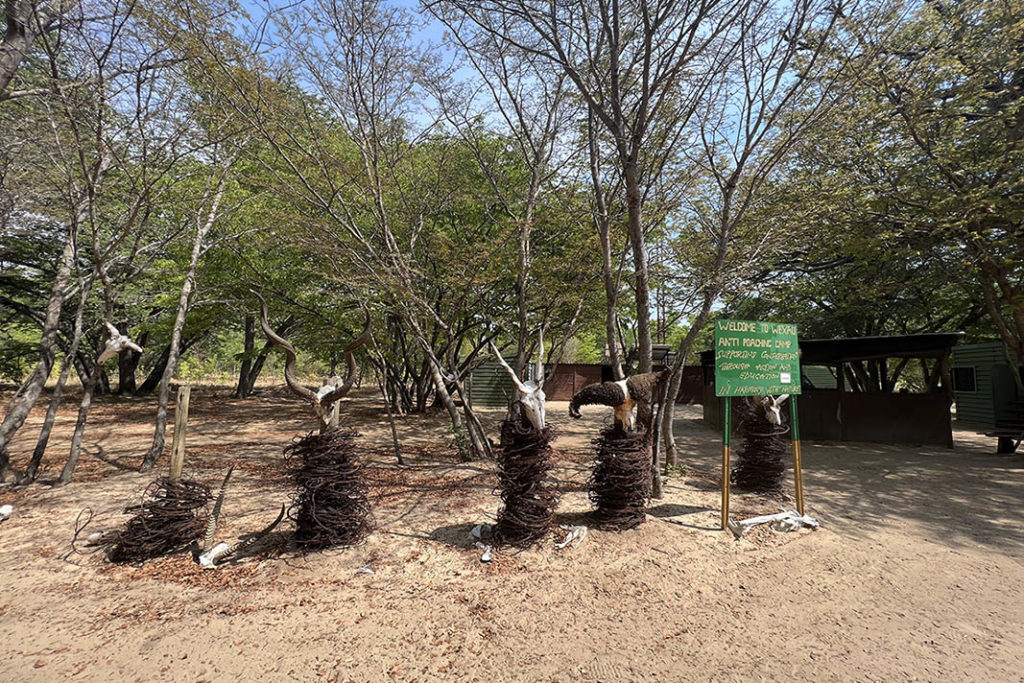
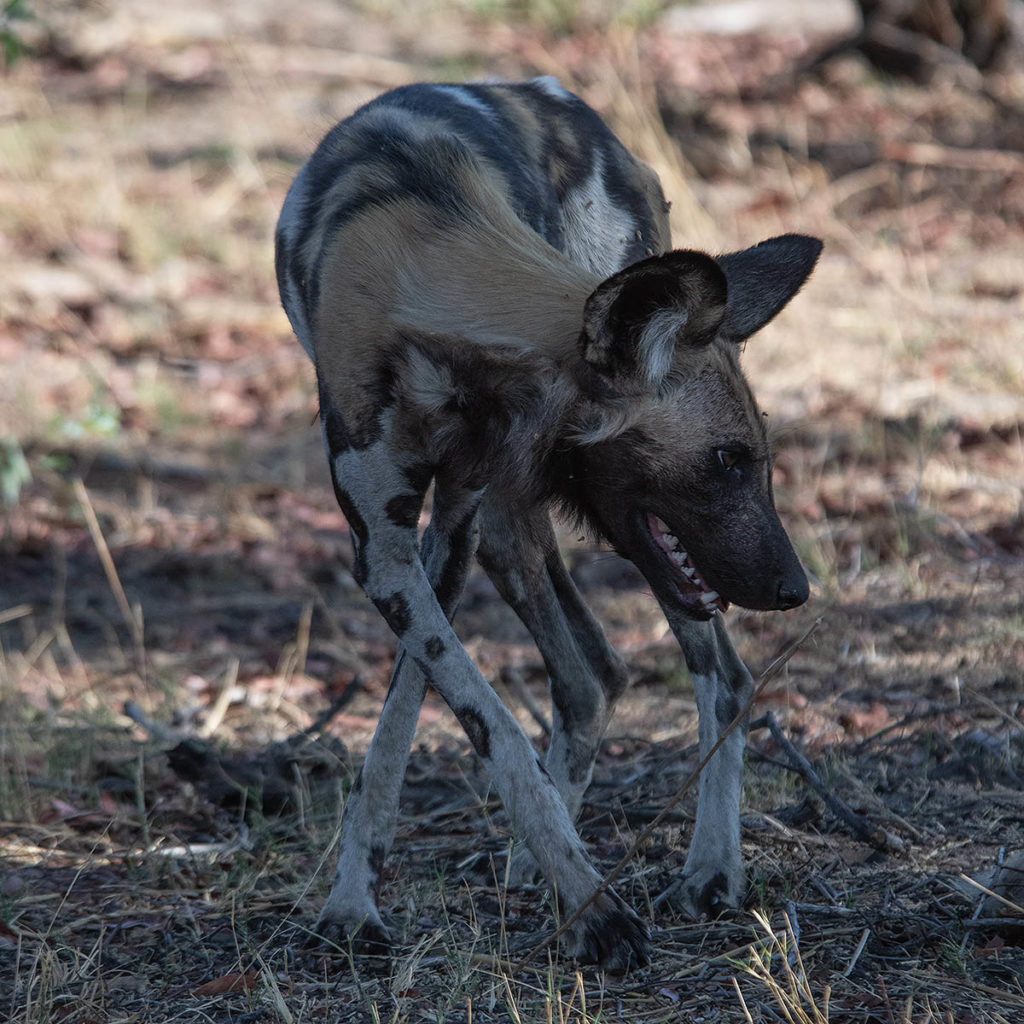
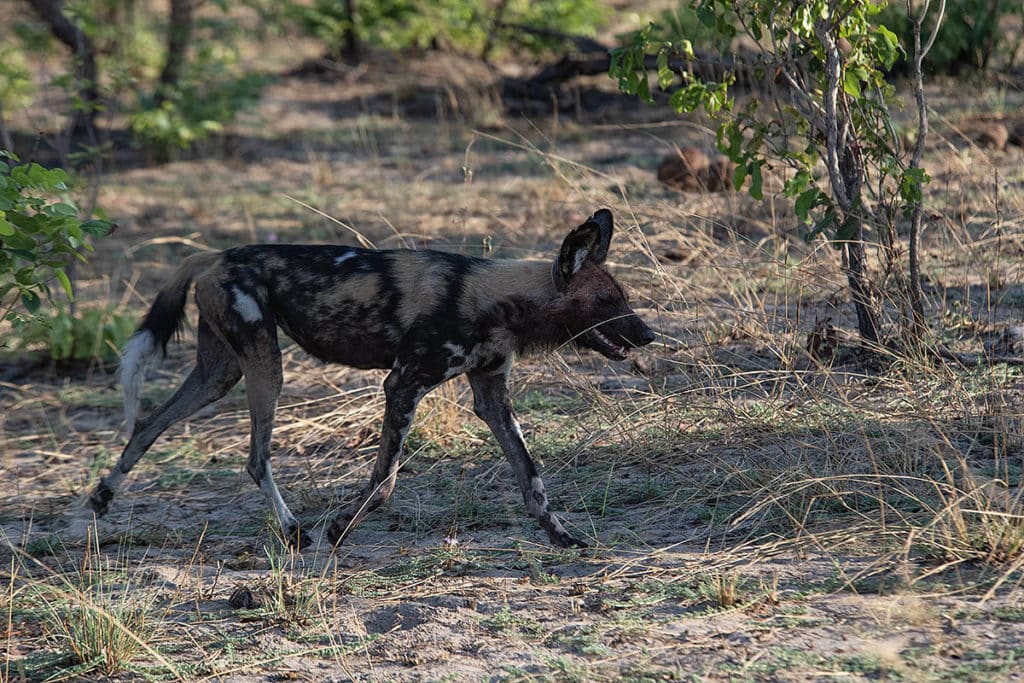
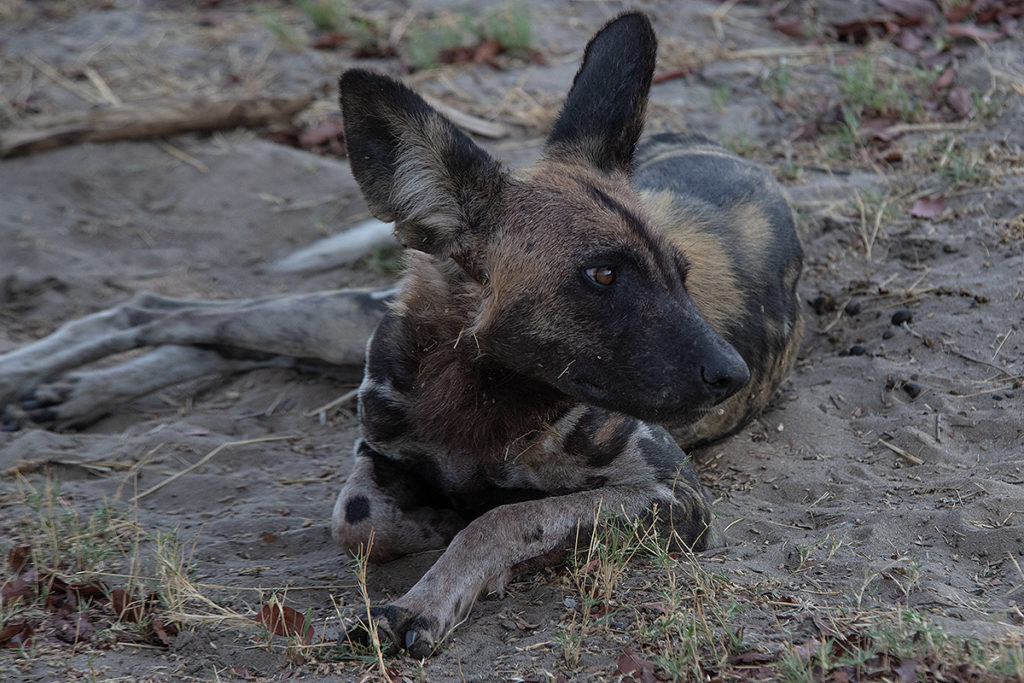
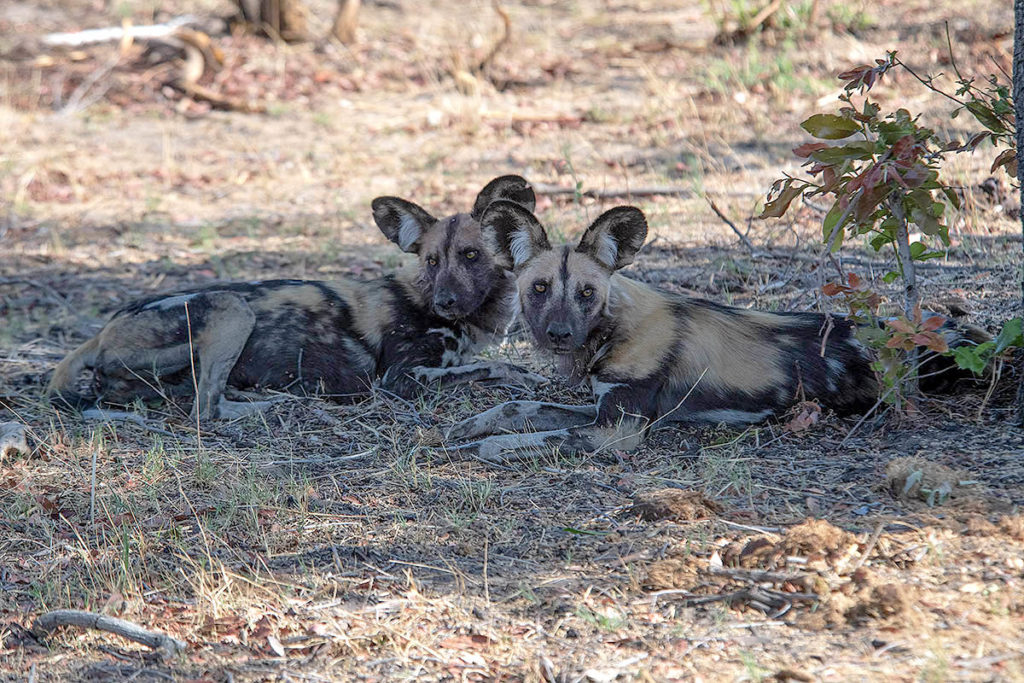
3500 snares
The base camp is in the middle of the forest. Leader Shelton Nkomos talks in detail about how his team works. “We have removed 3,500 iron snares since our inception, which means we have saved 3,500 animals. We are proud of it. Unfortunately, we still find many animals seriously injured or dead; because once they fall into a trap there is no going back.” Shelton demonstrates how the wire drop works like a small lasso. “Look, the poachers attach the snare to a tree stump or a stone and place it in a loop on the ground. As soon as an animal steps in or gets its head or shoulders into it, suffocation follows or the iron cuts deep into the limbs.”
Bycatch
The big problem is bycatch. Poachers want bush meat, which is mainly antelope or boar, but any animal can get caught in a trap. Poachers set multiple traps, while they can take ‘only’ one captured animal. That’s bad enough, but all the bycatch is left behind and dies a pointless death. When large animals are injured and have a chance of survival, SAPU calls in a veterinarian. During one of our walking safaris we accidentally find a bow. Fortunately without a victim, but the thing is just lying on the ground. At least we were able to spare the life of one animal. However, the day before our visit we saw a young elephant that barely had a trunk. There is a good chance that the animal has been stuck in a trap and therefore has difficulty surviving due to its disability.
Financial fines
Fortunately, the numbers of snares are decreasing somewhat, partly thanks to education and projects such as Children in the Wilderness (see box). Also because there are more employment opportunities for locals with tour operators. “We caught a lot of poachers. There are heavy fines for trespassing in the park without a permit, spreading a snare and capturing wild animals. The costs increase so much, especially when catching endangered and large animals, that perpetrators cannot afford this and end up in prison.”
More manpower
The SAPU team patrols the park’s border every day by car, covering about ten kilometers on foot in search of snares. All information is recorded in a database. Sometimes they stay in one place for several days. By working together with locals and organizations such as Hwange Lion Protection, which is part of WildCru,they can mutually warn and support each other when predators or elephants come close to the buffer zone. “With more manpower and an extra car we could achieve much more in this immense area. And if more animals were to wear a GPS collar, we could protect them better.” ↓
WILDERNESS
Wilderness celebrates in 2023 40th anniversary. The company was founded in Botswana and operates in nine countries; mainly in Southern Africa. It describes itself as ‘pioneers of purpose’. Wilderness is not the only high-end tour operator committed to nature conservation, biodiversity, education and sustainable tourism, but the scale and way in which they do this is quite unique and they have won many international awards for their efforts. In addition, their luxury lodges are of a very high standard, located in fantastic locations and the service from the staff is fantastic and genuine.
Theory of change
Wilderness pays a lot of attention to their ‘Theory of change’, by effectively focusing on habitat conversion, climate change and human wildlife conflicts. This is all about protection, education and self-awareness. They provide employment to local communities and play an important role in partnerships with national parks and wildlife organizations. Wilderness employs approximately 3,000 people, spread over 60 lodges and 2.3 million hectares of land.
Wilderness Trust
Since 2022, the Children in the Wilderness and Wildlife Trust foundations have been merged under Wilderness Trust. The former is fully committed to education, awareness, management and involving local communities in wilderness living. The Wildlife Trust focuses on various conservation projects and scientific research such as the Scorpion Anti-Poaching Unit (Zimbabwe), Lion Recovery Fund, Namibia Desert Lion Conservation Project, Save the Rhino Trust (Namibia) and Hwange Elephant Movement Study.
Children in the Wilderness
The Scorpion Anti-Poaching Unit has already been able to educate many local children about their work and the importance of protecting wildlife in Hwange. Team leader Shelton Nkomos: “Through Children in the Wilderness we can change the mindset of young generations, so that, for example, they see an impala not just as food, but as an important animal for the ecosystem. And that they pass on knowledge to their parents and can benefit from it themselves by being active in tourism and nature conservation. Potential poachers also know through their children what the consequences could be if they are caught and that deters some from going hunting.”
Read more soon about our school visit in the town of Ngamo and the powerful craftswomen who make beautiful, handmade baskets and placemats from recycled plastic under the leadership of power woman Nomaqhawe Moyo.
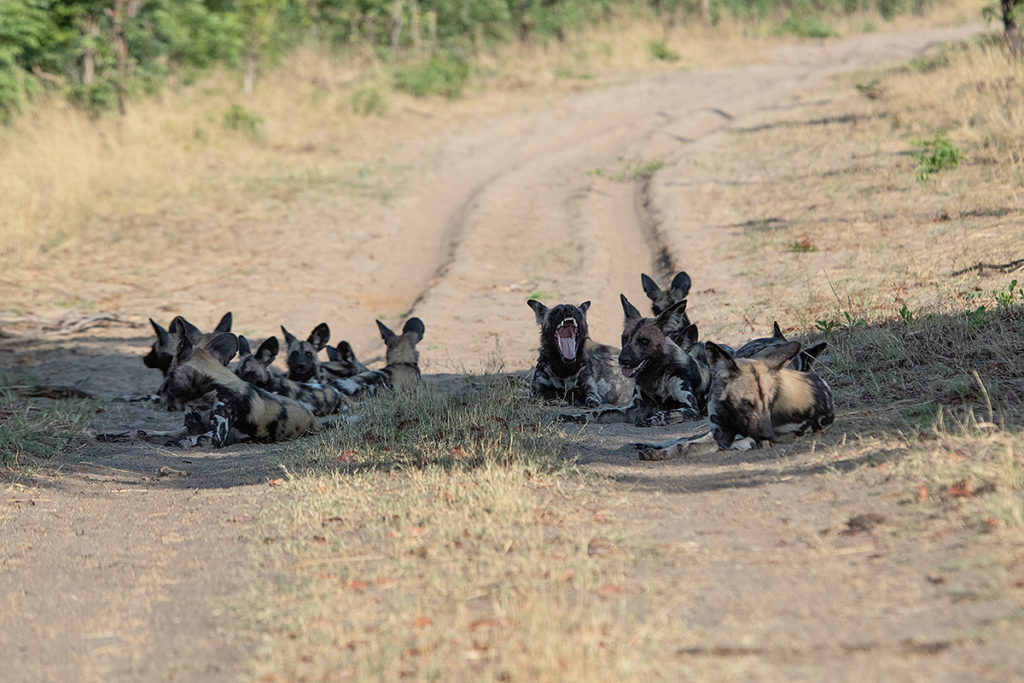
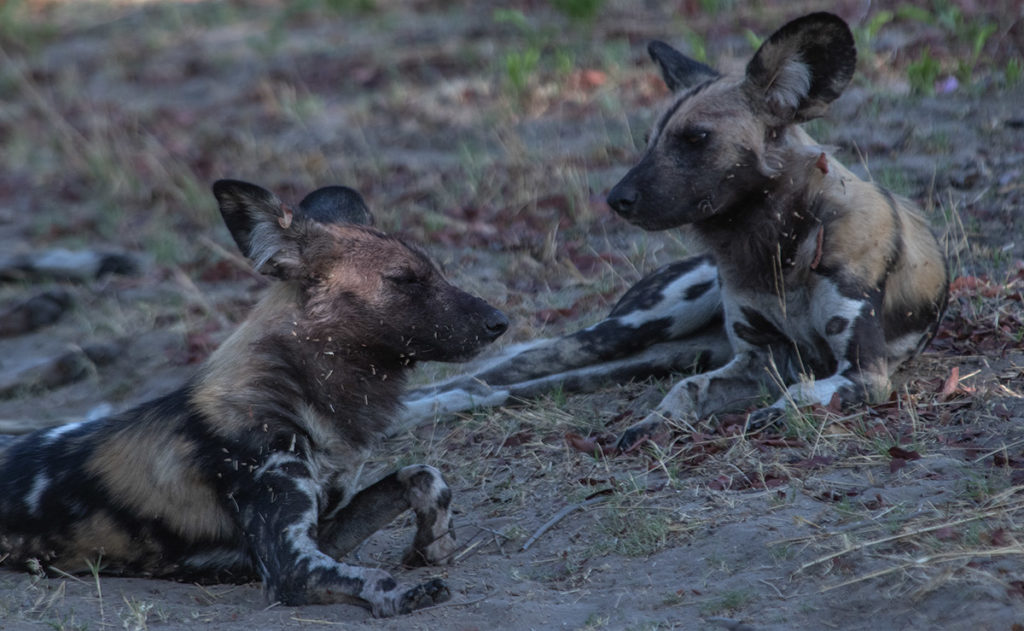
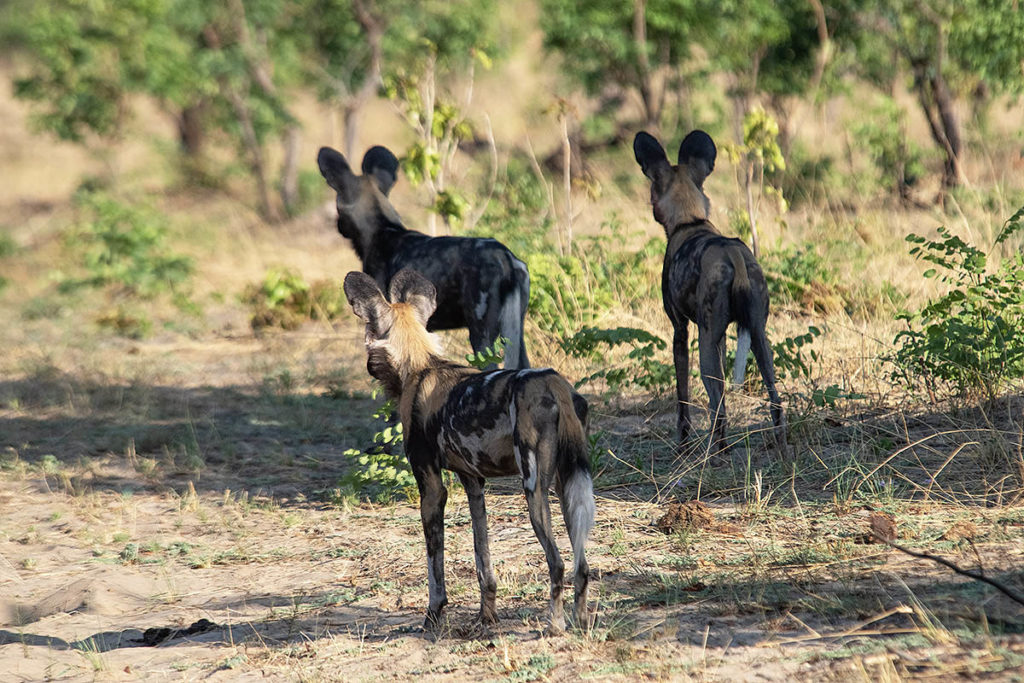
Would you also like to contribute to the protection of painted dogs in Zimbabwe?
PDC urgently needs new GPS neckbands to be able to trace the dogs and thus protect them. These tires last an average of three years and some of them need to be replaced or broken. A tire costs about $800-1000 each. Antennas, radios for mutual communication and night cameras are also needed. There are even more ways to support, see HERE
Gift tips
- PDA director Peter Blinston and photographer Nicholas Dyer released the coffee table book Painted Wolves, A Wild Dog’s Life out with 300 illustrations and 220 photographs. All proceeds go to the Painted Wolf Foundation.
- At Wilderness we drank delicious wine from a special winery: Painted Wolves. Exclusive wines with beautiful labels, of which every bottle sold goes to the protection of the painted dogs.
Painted Dog Conservation
Another non-profit organization with which SAPU collaborates and which has been specifically committed to the protection of the African wild dog since 1992 is Painted Dog Conservation (PDC). Led by Peter Blinston and Gregory Rasmussen, the organization is active in Hwange with their own anti-poaching unit, they have their own shelter for sick and injured animals, they provide information to schools with their Bush Camp program and they run their own visitor center. and research center. PDC also offers more than 60 workplaces to local communities. For example, artisans in the Iganyana workshop make animal figures, key rings, jewelry and other art from the iron bows that have been found. The organization alone removes around 3,000 (!) snares every year, saving dozens of dogs. PDC also conducts research into the demographic population and social behavior of the painted dogs in Hwange, Central Zambezi and Mana Pools.
Monitors Mana Pools
Unfortunately the visitor center is too far away for us, but in Mana Pools we speak with Geshem Njamba (30) and intern Tinashe Sukita (23); two PDC employees.Mana Poolsis an hour’s flight from Hwange. It is a breathtaking area, with very green and varied vegetation, located on the mighty Zambezi River. Geshem and Tinashe talk in detail about their fieldwork and the protection of the African wild dog. About the various troops living in Mana Pools, such as the Nyakasanga, Nyamatusi and Ruckomechi packs, which are also monitored daily using GPS collars. And they keep an even closer eye on the dogs that do not wear a collar in collaboration with Wilderness. ↙
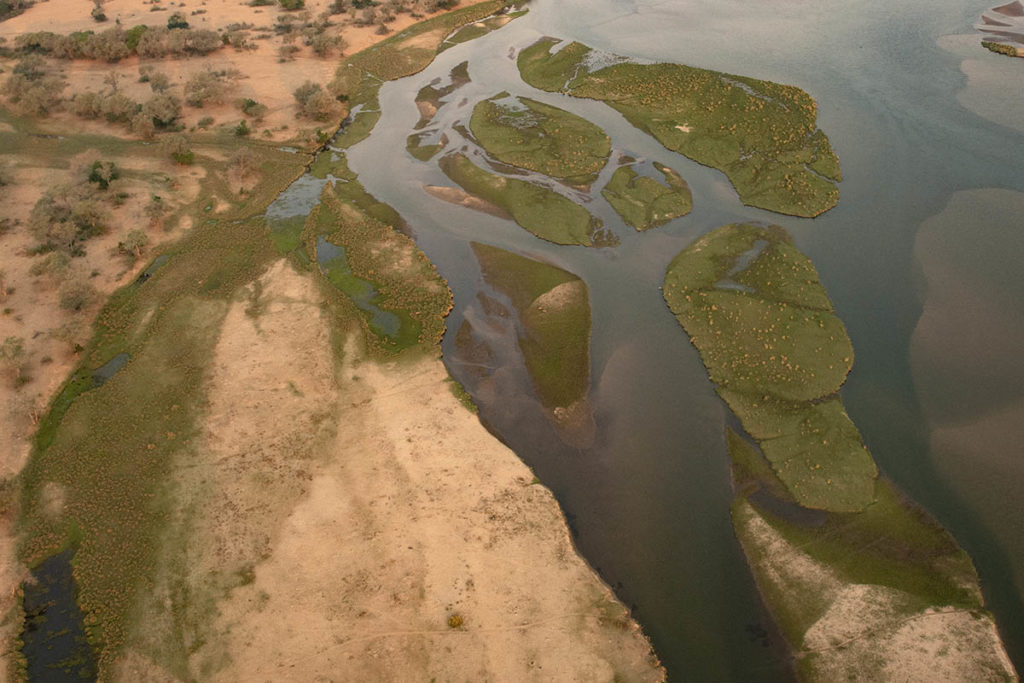
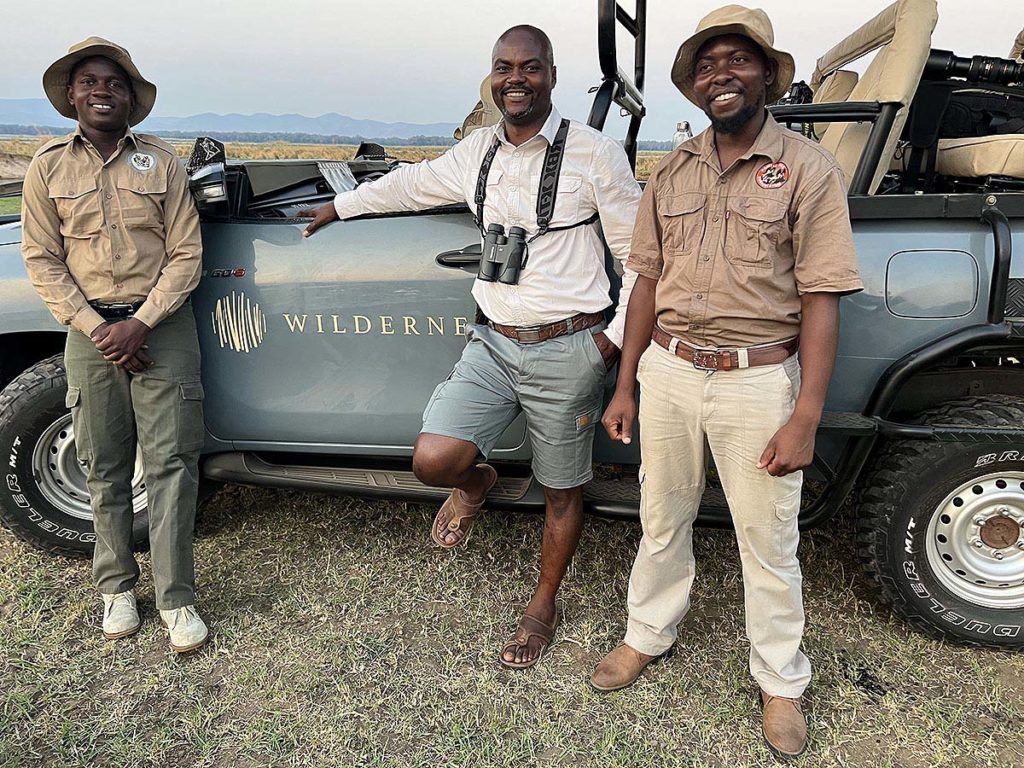
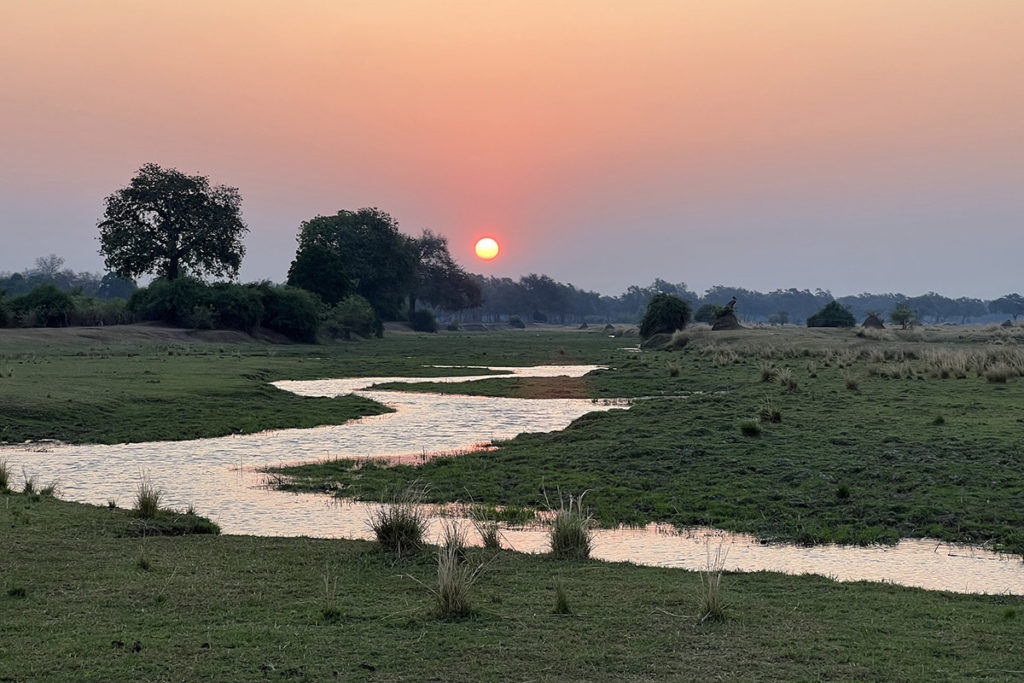
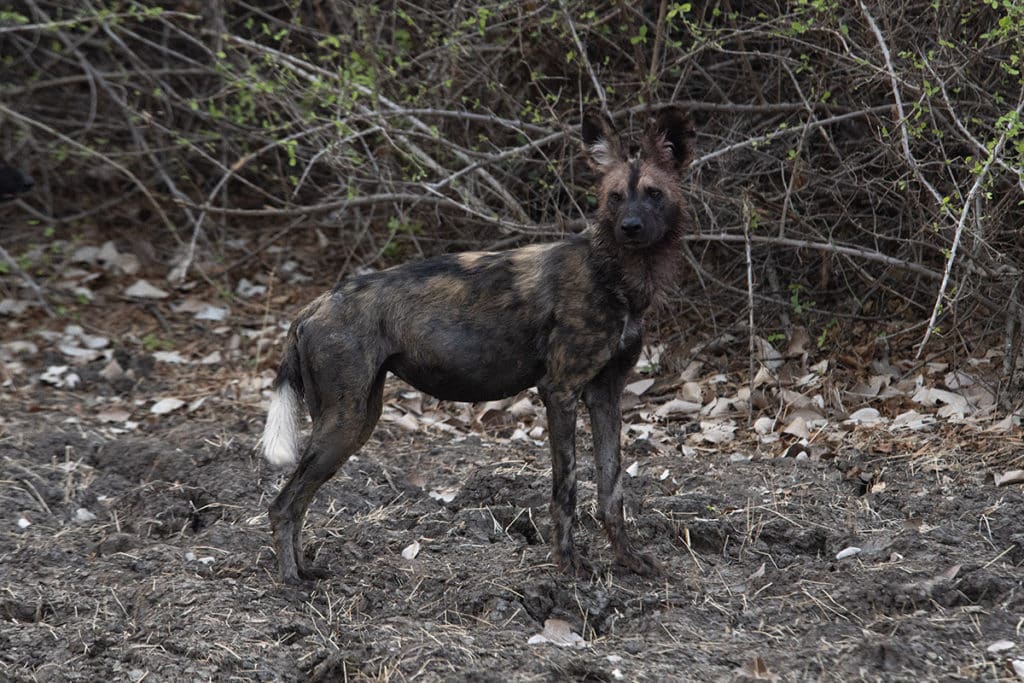
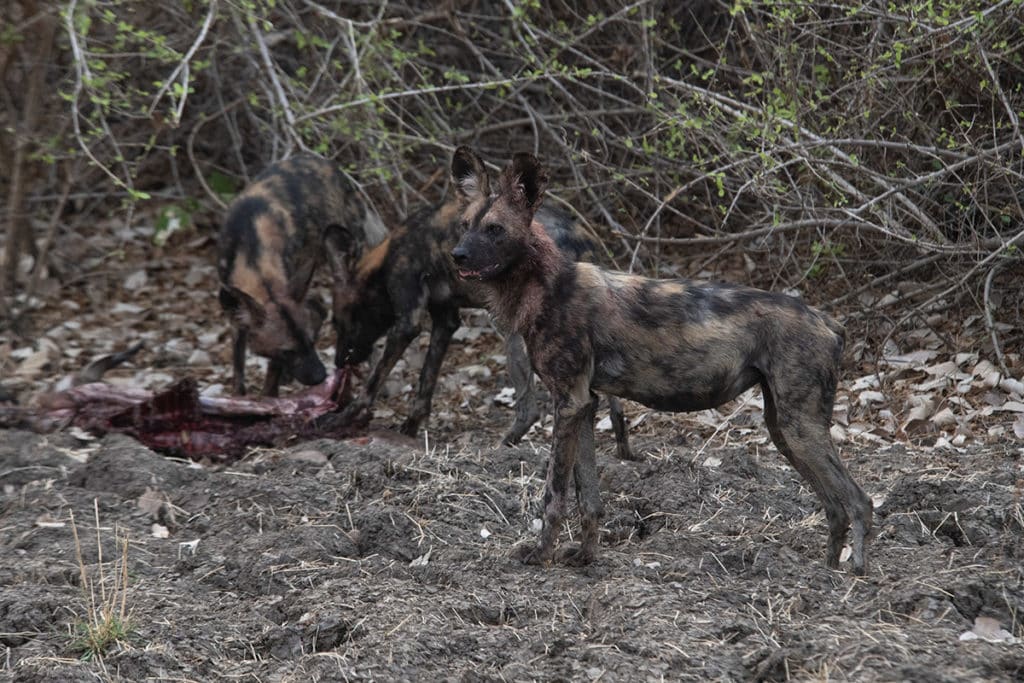
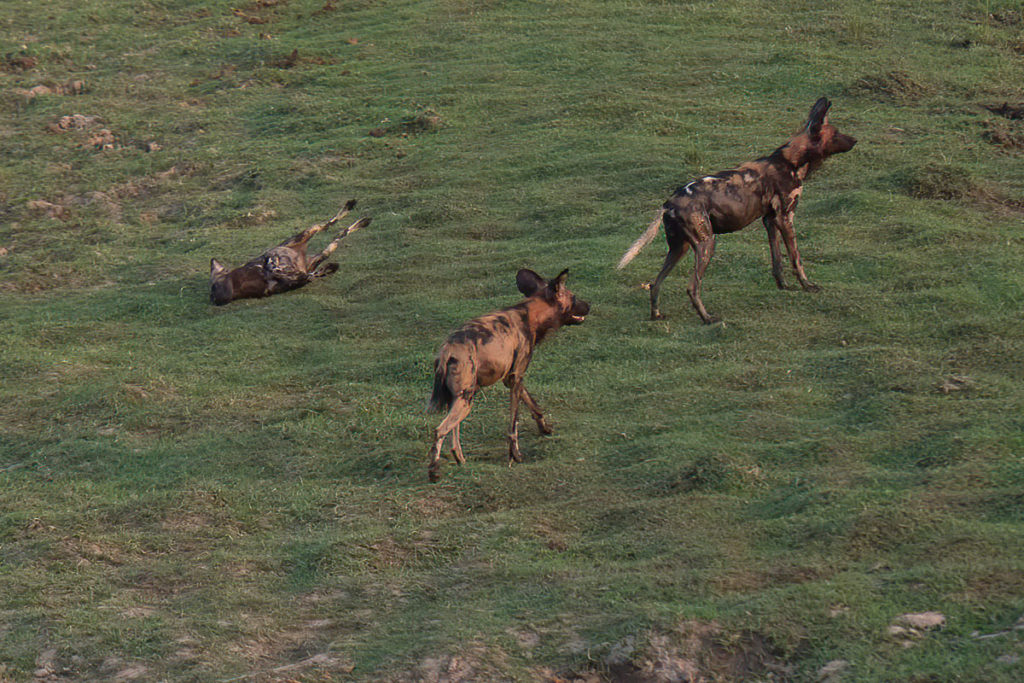
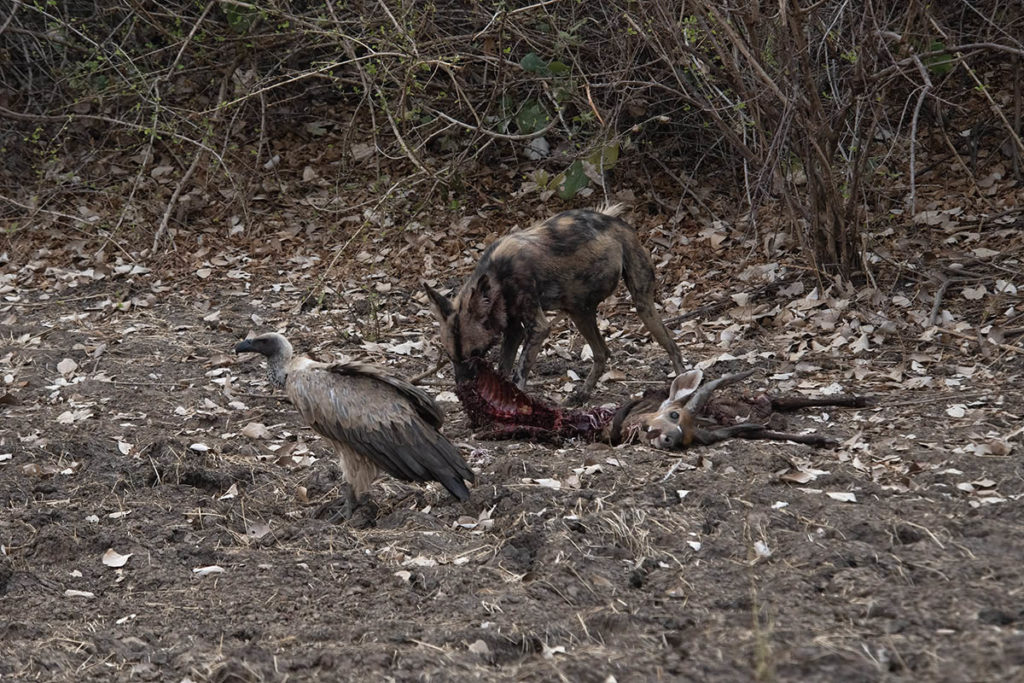
Well informed
The Wilderness guides report how many dogs have been spotted, in which location, what they look like and whether they are in good condition. “It is very valuable for us to receive recent information during game drives. We are then well informed how and where the dogs are, where they are going and how much distance they cover.” Geshem and his team use a special identification form to record all the characteristics of every dog they see. And they regularly take stool samples to examine DNA development and their dietary patterns.
Family member
Geshem says that it is a challenge to combat poaching, especially in Hwange, even though local involvement is paying off. Poachers also come from further outside the park to catch bush meat. Geshem: “Recently four dogs from the same pack were caught in a snare three times and were injured as a result. Fortunately, they recover in the shelter, but next time it could be fatal. Every time we lose one of the dogs, it feels like we have lost a family member,” says the ranger sadly. “At PDC we fight so hard for their survival and we know all the dogs of Hwange and Mana Pools. That is sometimes difficult, especially when puppies die prematurely. But it is also grateful to be able to help this special breed.”
Ilala pack Mana Pools
In the remote Chikwenya concession of Wilderness, which is located in the east of Mana Pools, there is now only one pack of painted dogs, called Ilala. They have not yet been able to reproduce because it is a fairly young group and sometimes it does not work right away. While the savannah is still awakening and the sun turns orange, we are already in the car with Wilderness guide Joshua Magaya. He has high hopes of spotting the dogs, because they had been seen in the area the days before.
We drive on unpaved winding roads, where trees and waterholes complement the picturesque plains. And the closer we get to the Zambezi River, the greener the vegetation. Everywhere we see impalas, elks, kudus, buffalos and baboons. Joshua scans the plains for the dogs. “They regularly hunt in this area because they have a good overview from the water surfaces and can move quickly,” he says.
High-pitched squeak
Suddenly he sees a hyena and hears a recognizable, high-pitched screech in the distance. The car continues to drive. “There they are!”, I shout, pointing to a large bush. The pack of four is almost invisible due to their camouflaged fur on the dark background. They have caught an antelope, which is being pulled hard. Sometimes, when food is scarce, the dogs also hunt baboons. As far as we know, Mana Pools is the only place in Zimbabwe where the predators do this. Guide Josh says that many baboons live here and because of the plains they are easy for the dogs to grab. The ‘wagging’ tails swish back and forth busily. A number of vultures watch the scene from a distance, hoping that something of the carcass remains for them.
Vomiting
The dogs look healthy. Then one seems to vomit. “They do this when they have puppies or for other animals in the group that are weaker or have been left behind at the den. Painted dogs cannot drag prey to their dens; it is too heavy and often too far away,” Joshua explains. However, this group has no puppies, but they do vomit. “It may have eaten too much or it may be automatically storing it in the back of its mouth, as a natural reflex. The undigested meat has to be removed at some point.”
Enchanted
After fifteen minutes the dogs seem to be full and leave the carcass behind. They quickly walk to the water surfaces to cool off, roll in the grass and rest. As we enjoy the spectacle, we are enchanted by the powerful bond and beauty of the painted dogs. We can only hope that the love for this endangered species increases in all who have the opportunity to see them. ![]()
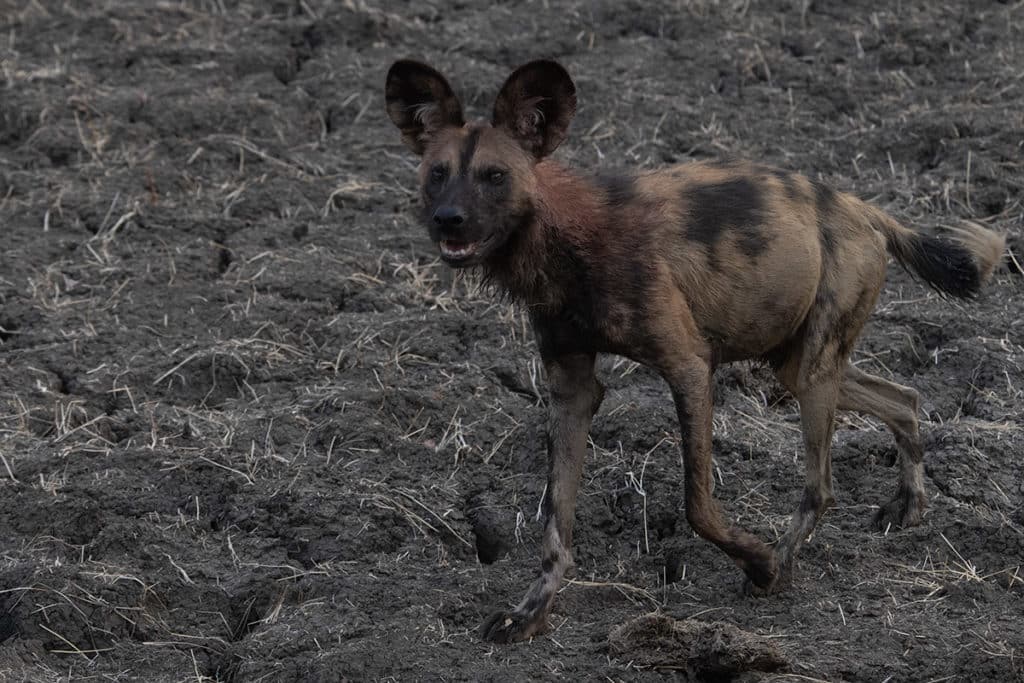
Stay Hwange
Davison’s
Wilderness has four of its own lodges in Hwange NP. We stayed at two different locations. Davison’s breathes the atmosphere of an adventurous, classic safari camp. In total, there are nine tents, each with a beautiful view over the savannah and waterhole where animals regularly come to drink.
These sturdy canvas tents are quite compact, but beautifully decorated with natural shades and materials. The privacy of the toilet and shower will soon be improved with a separate outdoor unit. There is also one family tent for four to six people.
The general meeting room is equally pleasant and serves for breakfast and dinner or to enjoy the view and/or campfire in the evening. And there is also a small but refreshing swimming pool where you can relax in the heat.
Linkwasha
The nine tented suites of Linkwasha are a bit more luxurious and spacious than at Davison’s. This accommodation is really very tastefully decorated with beautiful accessories and furniture. There is a wide and very inviting terrace, that has an amazing view over the waterhole. Linkwasha also has a family tent.
The central space, including (espresso) bar, seating area, separate restaurant and library, an extensive terrace and swimming pool, also form a beautiful whole. And the relaxed staff handles all requests with ease.
Hidden look out
Less than a hundred meters from the public terrace, there is a sunken container that Wilderness guests can use to observe and photograph passing game up close without the animals notice. It is an amazing experience to see elephants and giraffes bathing in the water hole up close from an underground bar – including drinks.
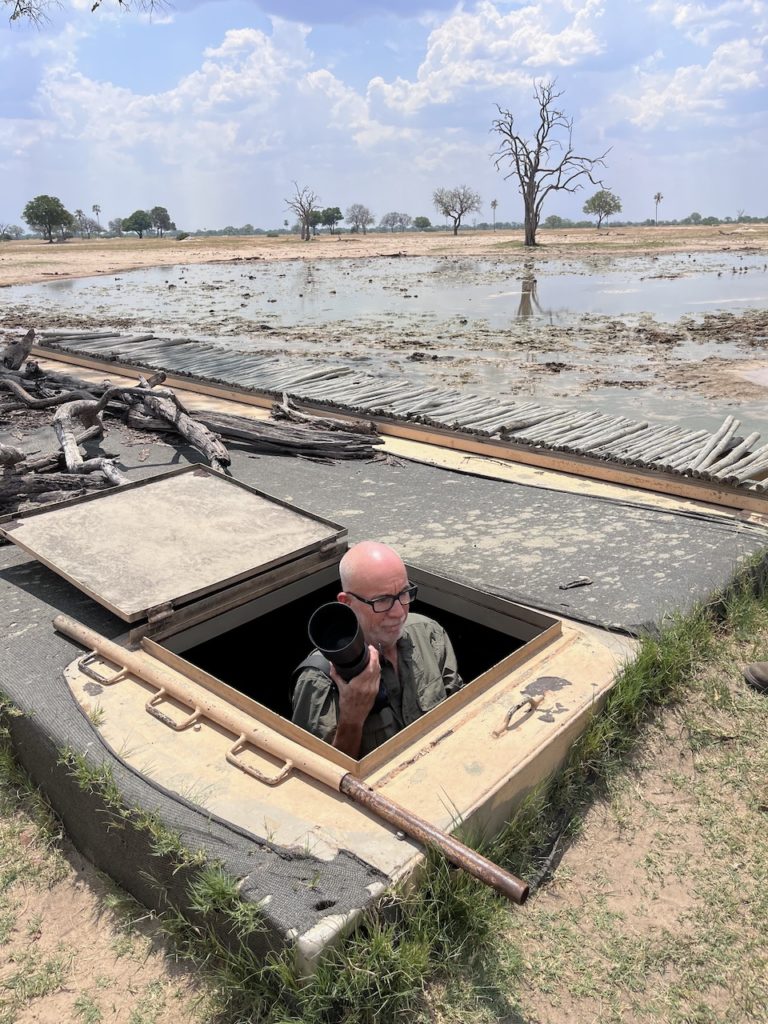
Stay Mana Pools: Chikwenya
In the northern Mana Pools NP, Wilderness also has four of its own camps. We stayed two nights in Chikwenya. Here you can eat outside in good weather on the natural terrace overlooking the floodplains of the Zambezi River. It is a true paradise, where animals are always strolling by in the distance. You can also stare at the ever-moving landscape for hours from the swimming pool.
Here too you will be served culinary dishes and the staff is extremely friendly and knowledgeable.
Chikwenya also has nine luxurious and spacious tents – including a bath and indoor and outdoor shower, where the water is heated by solar panels. There are four family tents in total. Don’t be alarmed by the rustling in the evening, because there are many grazers that forage around the tent in search of food.
Service
The service at all camps, as we have come to expect from Wilderness, is truly fantastic. This also applies to the food, which consists of healthy, local and seasonal ingredients and dishes. Since 2017, Wilderness has been eliminating plastic packaging, minimizing waste. In addition, all kinds of drinks are available and the sundowners are a real treat!
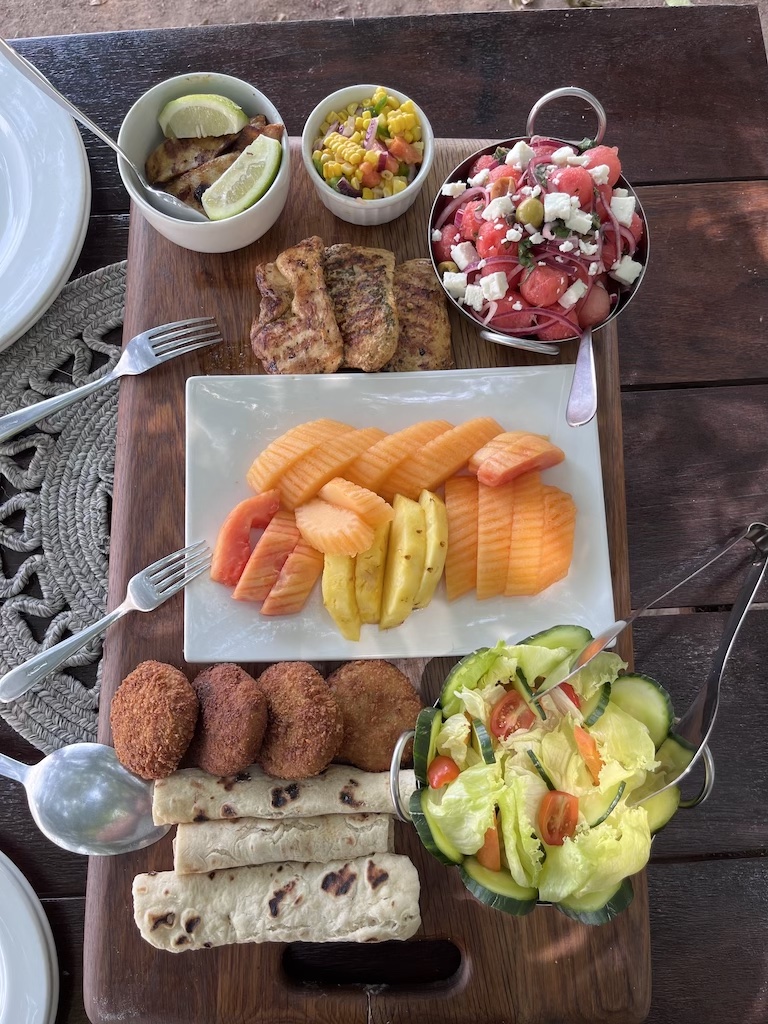
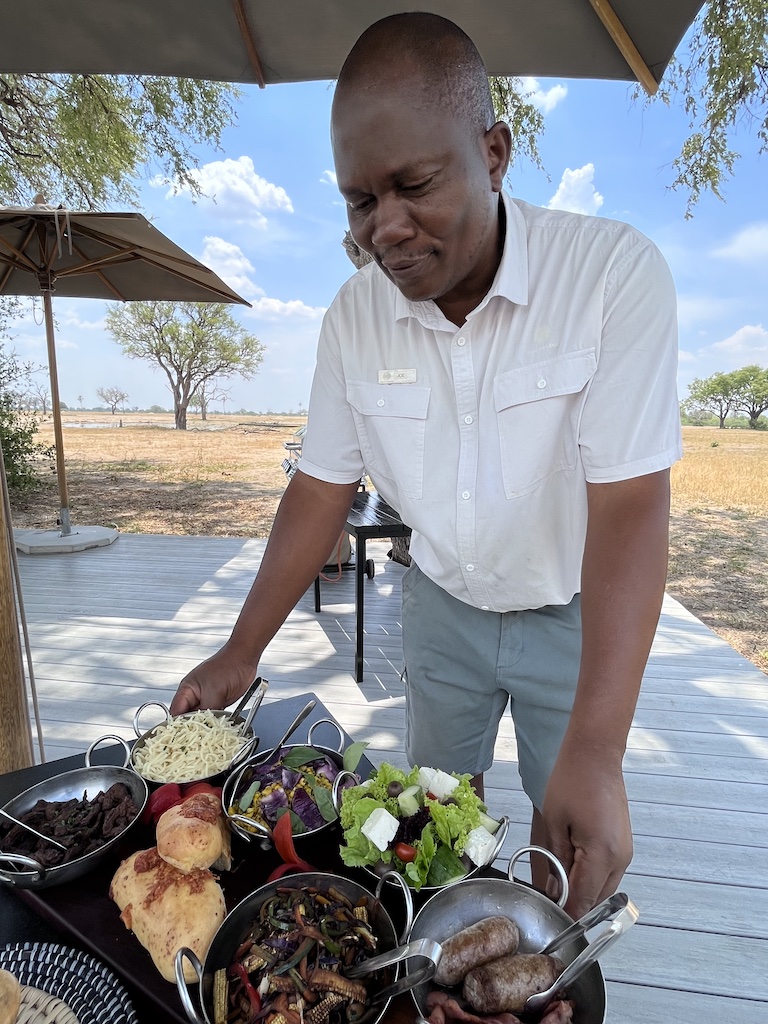
Zimbabwe Practical
Flights
There are no direct flights to Zimbabwe. There are various providers. Ticket prices can vary greatly, from 500 -1500 euros on average per flight.
Health
For Zimbabwe it is recommended to vaccinate for DTP (Diphtheria, Tetanus and Polio) and Hepatitis A & B (infectious jaundice). Malaria certainly occurs in wildlife parks. If you stay longer than a week, it is wise to take malaria pills.
General
Capital: Harare
Time zone: 1 to 2 hours later, depending on summer/winter time
Language: English
Currency: US dollars
population (2022): 15.178979
All-inclusive
Those who travel with Wilderness book all-inclusive, including transport. Only excluding the international flight.

